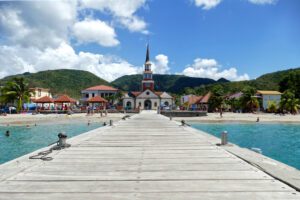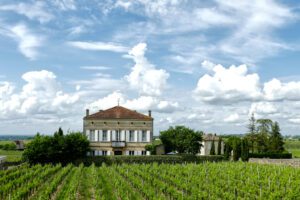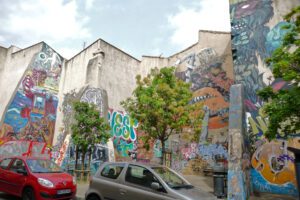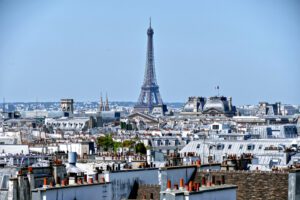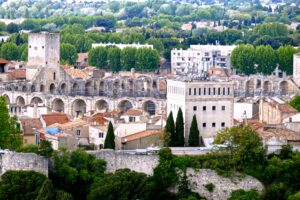It all began with a student exchange ages ago. Since then, I’ve probably visited Bordeaux more often than any other city, not just in France but in the entire world. While on my early visits, I focused more on the café culture, the clubs, and the laid-back charm of southwestern France, only now, in my advanced years, am I discovering the cultural treasures that no visitor should miss when visiting Bordeaux.
Therefore, I’m delighted that you’re joining me on this rediscovery of a city that has been so dear to my heart for such a long time!

Bordeaux And I
I was just 15 when I first visited southwest France. My high school had an exchange program with three high schools in Mont-de-Marsan. Mont-de-Marsan’s population is less than 2% of Hamburg’s, hence the 1:3 ratio.
After a group of French students had been assigned to us Hamburg students and our families for three weeks in the spring, we took the train to Mont-de-Marsan the following fall. That’s right: we took the train. First, we went from Hamburg to Paris, and then, after a few hours’ layover, we went from Paris to Morcenx, where we had to hurry to catch the regional train to Mont-de-Marsan. There, our exchange students and their families were waiting for us at the station. We had developed heartwarming friendships since we met earlier that year in the spring. But some of us had also taken the opportunity to already become ferocious enemies.
At the train station, however, the enmities seemed to be forgotten for a short moment. The prospect of three weeks in a household where everyone seemed to be somehow more elegant and more sophisticated than us Northerners was too exciting. Everybody here had a more melodious first name, and they dipped fluffy pastries in coffee with milk for breakfast.
Totally savoir-vivre.
Bottoms Up!
After we had finished the coffee with milk, with some crumbs and little puddles of butter floating in it, it was time to go to school. The program called for us to dutifully accompany our exchange student to school every day and attend classes. Somehow, this part of the program never really worked out. I remember going to class with my first exchange student, Catherine, just once.
Nevertheless, one thing from this visit has remained with me forever. While in Germany, school ended at noon and everyone went home for lunch, in France, the school day lasted until the afternoon. Therefore, kids were given lunch at school. This included us exchange students. However, since we were cherished guests from foreign lands, we were also offered wine as a drink.
We were 15! We were in a school cafeteria! It was midday!
Savoir-vivre is serious business in France.
Vive la France!
All this exoticism, combined with the beautiful, melodious language, led me, after two exchanges, to develop a deep love and connection to southwest France. And, of course, friendships. I went there so many times, even as I was far too old for an exchange program, that I can’t even count them anymore.
At some point, our former exchange students graduated from high school and went from Mont-de-Marsan to study at the university of the more or less nearby city of Bordeaux. I went with them, so to speak. Instead of going to Mont-de-Marsan, I now took the train to the wine capital of Europe twice a year. Yes, I still took the train. There were no low-cost airlines at that time. Flying was a luxury, and for me, absolutely unaffordable.
There was a train leaving Hamburg at 3 a.m. that arrived at Gare du Nord around noon. Completely exhausted, I had to kill five hours in Paris before finally continuing on to Bordeaux from Gare d’Austerlitz.
Nowadays, a trip like this is hard to imagine.
Those Were the Dayz
Two exciting weeks on a sofa bed awaited me in Bordeaux. We spent endless hours in sidewalk cafés and long nights in the city’s clubs. In winter, we didn’t even manage to see daylight for two weeks. By the time we finally dragged ourselves out of bed in the afternoon, heavily hungover and still half asleep, the sun had already given up, and it was dark again.
Life was wild, exhausting, and so much fun!
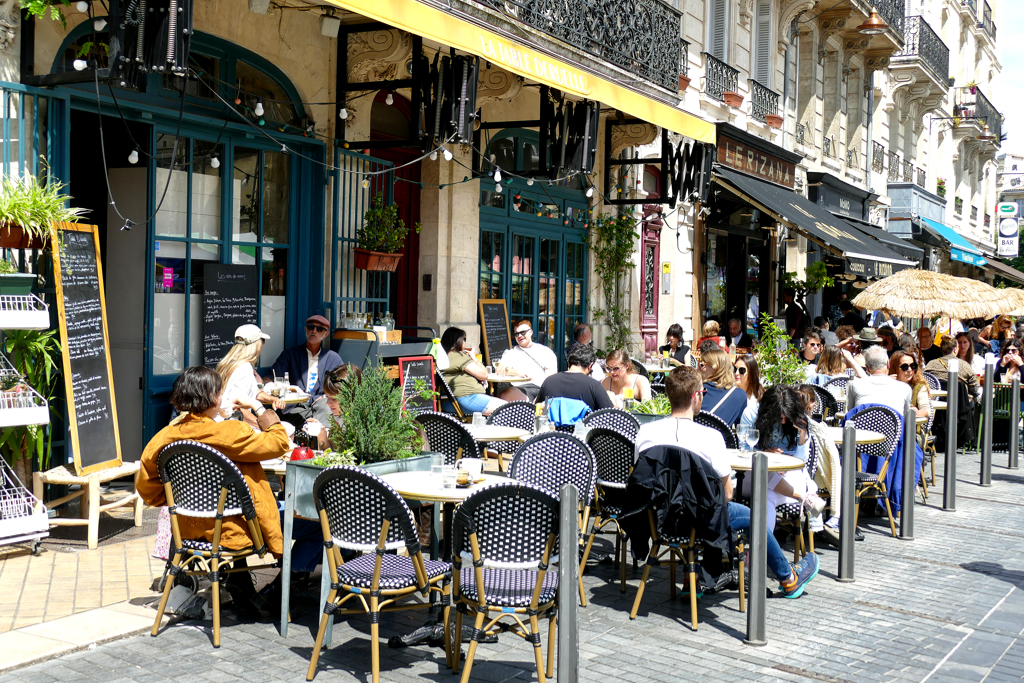
After a break of several years, I’m back in Bordeaux. Everything seems somehow familiar, yet different. Although there are currently no direct flights from Hamburg, I no longer travel the 1,500 kilometers by train. I also no longer waste my life in clubs, and I only sleep until the afternoon when I’m seriously ill. Nevertheless, that’s not as dull or boring as it might sound.
From a New Perspective
It must be said that I saw virtually nothing of the city during countless visits during my wild youth. Or at least very little. I saw a few cafes and clubs, neighborhoods where friends lived, and the Mériadeck shopping center. No museums, no churches, nothing of the sort.
Today, however, on my visit with a literally sober view of the city, it is a great pleasure—and also a matter close to my heart—to finally introduce this wonderful city, which was such an important part of my youth, on the blog.
Bordeaux
The city of Bordeaux stands for fine wines, magnificent facades, and the French way of life. But its history stretches back over 2,000 years and is full of fascinating twists and turns, great triumphs, but also some dark chapters.
The Romans were the first to recognize the potential of Bordeaux. Thanks to its strategic location on the Garonne River, commerce flourished, and the city soon became an important trading center for wine, ceramics, and other luxury goods. In fact, it was the Romans who brought with them not only their architectural expertise but, most importantly, the first vines. This way, they laid the foundation for today’s world-famous wine region.
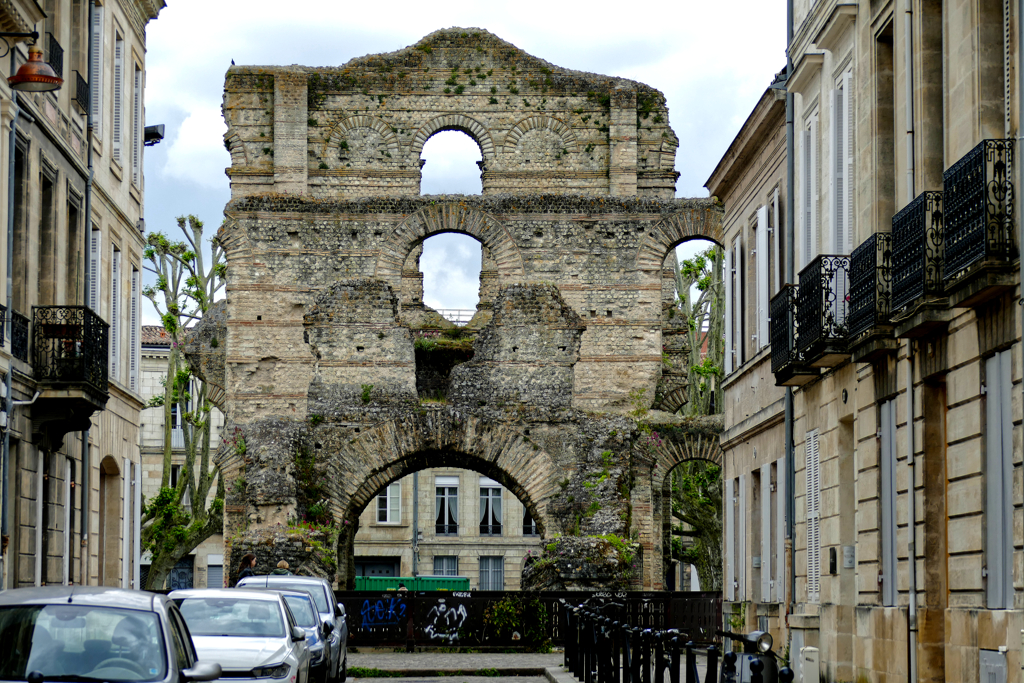
During the Middle Ages, Bordeaux experienced turbulent times. In 1152, Eleanor of Aquitaine married Henry II of England. Hardly anyone is aware that this way, the city became English for several centuries. Obviously, the wine trade with England flourished as Bordeaux shipped vast quantities of a light red wine called Claret to London.

However, during the Hundred Years’ War, friends became foes, and England and France fought bitterly for control of the Aquitaine region. In 1453, the French army finally defeated the English, and Bordeaux became French again.
The Gilded Age
The 18th century is considered Bordeaux’s Gilded Age. The city became a center of Atlantic trade, particularly in sugar, slaves, and, of course, wine. Consequently, the merchants invested their blood money immense wealth in magnificent buildings. The iconic neoclassical architecture still makes Bordeaux outstandingly beautiful today. The elegant Place de la Bourse is one of the most notable landmarks from this era.

Obviously, this prosperity had a very shady and grim side as Bordeaux became one of France’s richest cities through the so-called Triangular Trade. Ships brought goods to Africa, loaded people there, and sold them in the Caribbean. You can read more about this dark chapter that was long ignored and has only recently begun to be addressed in my post on the French Caribbean islands of Guadeloupe and Martinique.
Like all of France, Bordeaux was rocked by the French Revolution in 1789. The formerly prosperous merchants had to face a political wind of change.
Becoming a Boomtown
Starting in the 1990s, Bordeaux underwent a spectacular transformation. Then-mayor Alain Juppé restored the old town, banned car traffic from the city center, and installed a tram. Also, the waterfront was transformed into an attractive promenade. Bordeaux became a hub for art, design, and innovation. Today, it is one of the most beautiful and livable cities in Europe. In 2007, UNESCO put Bordeaux on its list of World Heritage Sites.

Follow me on a comprehensive tour, and you’ll understand why the city is considered the Pearl of the Southwest.
What Not to Miss in Bordeaux
Strolling through Bordeaux’s magnificent boulevards and romantic side streets, admiring the imposing architecture and being enchanted by small cafés and shops, it’s almost incomprehensible that the city only wholly embraced its full potential in the 1990s. To preserve its splendor, the old town, which has retained almost all of its historic appearance, was increasingly traffic-calmed, and the historic buildings were renovated.
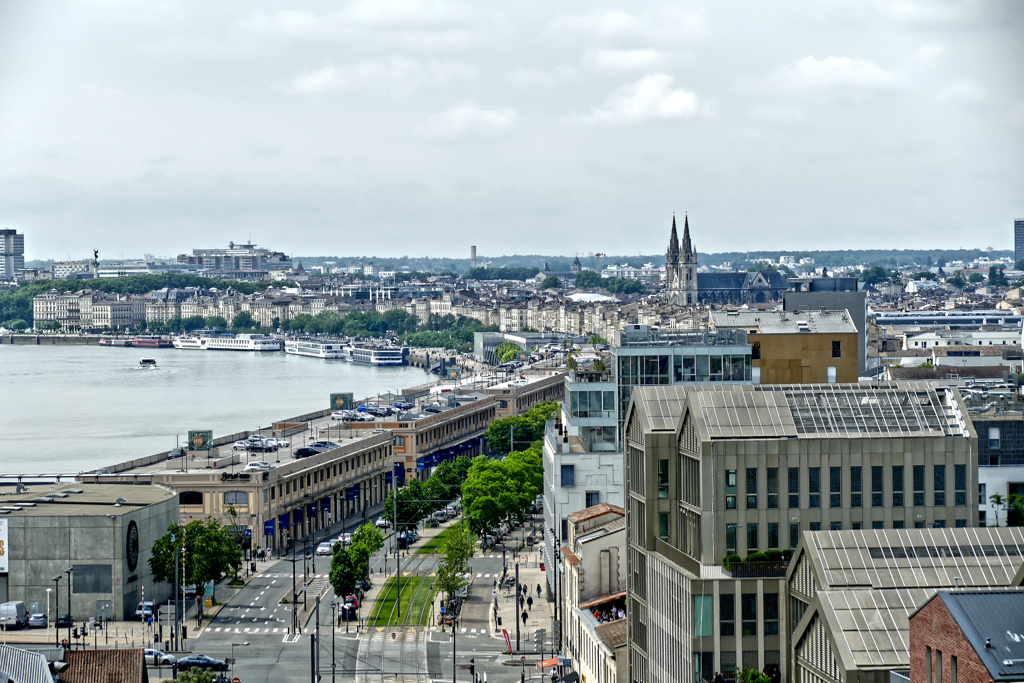
The former quays along the Garonne River have been restored and filled with independent businesses, shops, and hip bars and restaurants. Miles and miles of bike lanes and promenades wind their way along the river. Today, in addition to the historic city center, impressive new buildings such as the Cité du Vin and the unique Pont Jacques Chaban-Delmas are part of the city’s distinctive landscape.
As described above, I’ve always been a great advocate of the city of Bordeaux, and with this enthusiasm, something like a pioneer and a scout. Therefore, I’m incredibly excited to finally have the opportunity to introduce you to the city that’s so close to my heart.
Place Pey Berland
Since Bordeaux not only impresses with its outstanding individual buildings, but has also been able to preserve its appearance as a grandiose, almost completely preserved historical complex to this day, it is not so easy to choose a starting point.
I think Place Pey Berland is the best spot from which to explore the city. Firstly, it’s very centrally located. Secondly, it’s home to some of the city’s most important landmarks, while at the same time, with its many beautiful café terraces, it showcases the city’s relaxed, convivial side. Last but not least, the Tour Pey Berland observation deck offers a fantastic view of the whole of Bordeaux, so you get the big picture right from the start.
Cathédrale Saint-André and the Tour Pey Berland
The Cathedral of Saint-André is the largest and most important religious building in the city of Bordeaux. Over the centuries, important rulers have been married in the current Gothic cathedral and in its predecessor, consecrated by Pope Urban II. Since 1998, the cathedral has been on the UNESCO World Heritage List as part of the Way of St. James.

The isolated bell tower, Tour Pey-Berland, stands in front of the choir on the south side. It dates back to the 15th century and is named after Bishop Pey-Berland. The 50-meter-high tower was placed in front of the cathedral, built on marshy ground, to protect it from the vibrations caused by the bells. In 1863, it was crowned with the statue of Our Lady of Aquitaine.
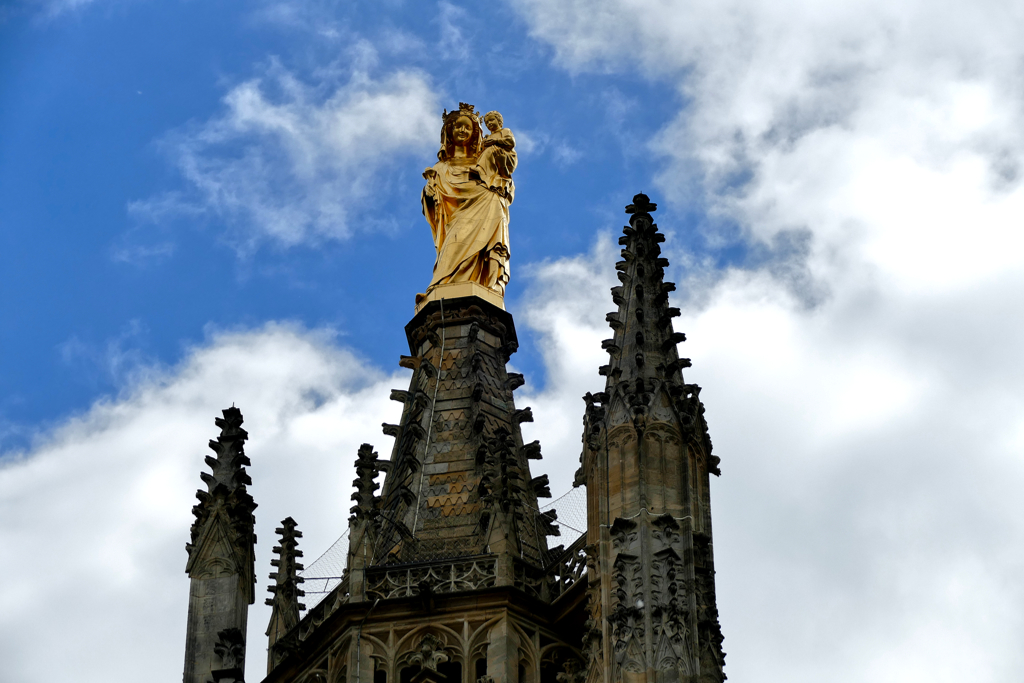
Due to a lack of bells, the tower was quickly converted into apartments! In the 18th century, the Tour Pey-Berland was scheduled for demolition. Since the Bordeaux people opposed the project, it was eventually sold and used as a lead factory.
The church repurchased the tower in 1851. Three small bells and one large bell were finally installed. The largest bell weighs eight tons and is nicknamed Ferdinand-André. The tower consists of four levels, the highest of which can be reached via 231 steps of a narrow spiral staircase.
Getting High
You can climb up for a general entrance fee of 9 €uros every day between 10 a.m. and 6 p.m. However, a visit to the Pey Berland observation deck is included in the Bordeaux CityPass**. Either way, you have to make a reservation on their website in advance.
You’ll find all the relevant information about this metaphorical key to the city below in the Cash, Cards, and Deals section.
Hôtel de Ville Palais Rohan
As I have explained in other posts, such as 10 Most Beautiful Palaces in the Marais Neighborhood of Paris, in French, a hôtel is not only a place to rest, but also various other things. For example, you certainly won’t be able to book a room in a hôtel de ville, as this is the town hall building. And this is also the case with the Palais Rohan, which in fact is Bordeaux’s city hall.
The building was constructed in the 18th century by the Archbishop of Bordeaux, Ferdinand Maximilien Mériadec de Rohan. It was designed as a classic so-called hôtel particulier in the neoclassical style with a grand portal, a spacious courtyard, and two ornate façades.

After the French Revolution in 1791, the building housed the Gironde department prefecture. Eventually, it served as an imperial palace for Napoleon in 1808 and a royal residence for Louis XVIII in 1815. Finally, it was converted for municipal use as Bordeaux’s Hôtel de Ville in 1835.
In the late 1870s, two new wings were added to accommodate the Musée des Beaux-Arts.
To visit the Palais Rohan, which is possible on guided tours on Wednesdays at 2.30 p.m. and 3.30 p.m. and Fridays at 10 a.m. and 11 a.m., you can purchase a ticket for 9 €uros on their website.
The art museum is open from Wednesday to Monday from 11 a.m. to 6 p.m., and general admission is 6 €uros. Both landmarks are included in the Bordeaux CityPass**.
Place Jean Moulin
On the north side of Place Pey Berland is one of my favorite squares in Bordeaux’s historic city center, Place Jean Moulin. Especially on nice days, the iridescent play of light between the dense foliage of the many trees is simply enchanting. On the north side is the former building of the Caisse d’épargne de Bordeaux, designed by the architect Henri Duphot. Today, it is owned by the municipality. It houses the Jean-Moulin National Center, a museum and documentation center dedicated to the history of the Second World War, particularly the French Resistance.
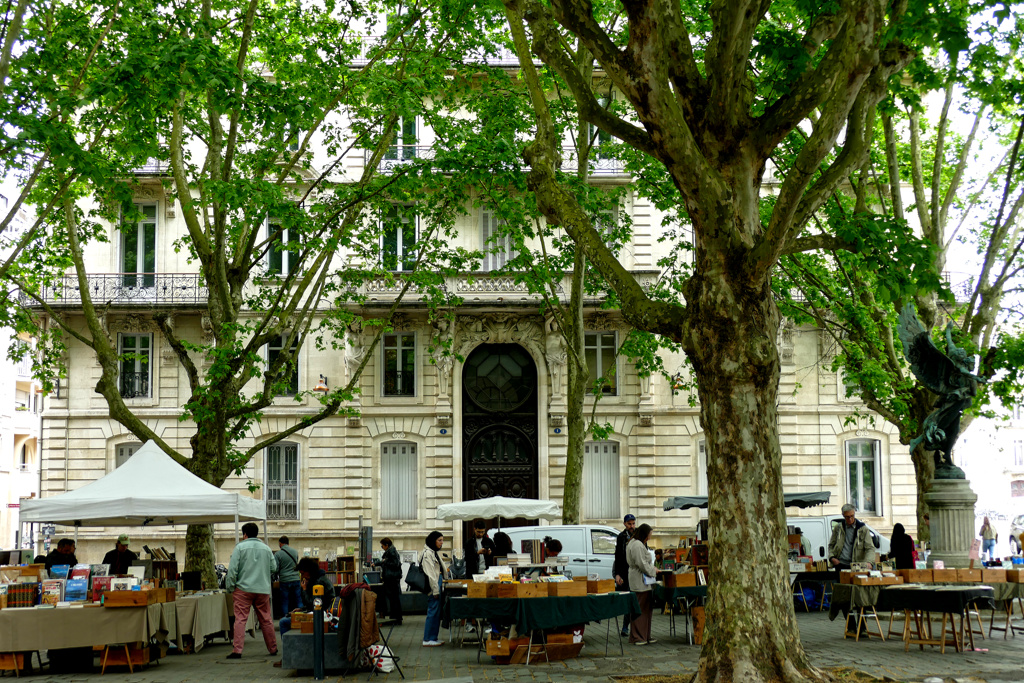
Unfortunately, the museum has been closed for renovations since 2018. Part of its contents have been transferred to the Aquitaine Museum, to which it is affiliated. The charming square, however, is still worth a visit.
Musée d’Aquitaine
The Musée d’Aquitaine is a regional museum of history, archaeology, and ethnology chronicling the rich history of Bordeaux and the Aquitaine region. It is housed in the former Faculty of Arts and Sciences building, constructed in the late 19th century on the site of the Feuillant convent. As a matter of fact, philosopher Michel de Montaigne was buried in the convent in 1592.
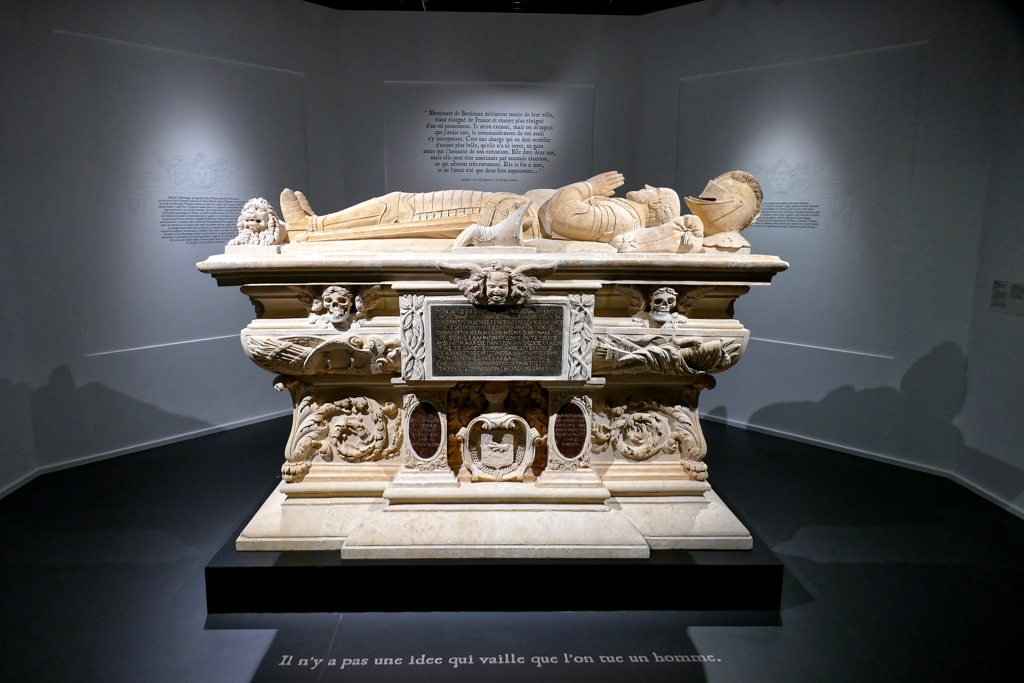
However, the quote on the floor is particularly noteworthy: Il n’y a pas une idee qui vaille que l’on tue un homme, hence, there is no idea worth killing a human being for.
The museum was established in its current form in 1963. Since then, it showcases the region’s history all the way from prehistoric times to the 21st century.
There are also approximately 5,000 pieces from Africa, Oceania, and the Americas. That those are supposed to be reflecting Bordeaux’s maritime connections is a popular euphemism museums in the Western hemisphere apply to pieces that were oftentimes simply stolen.
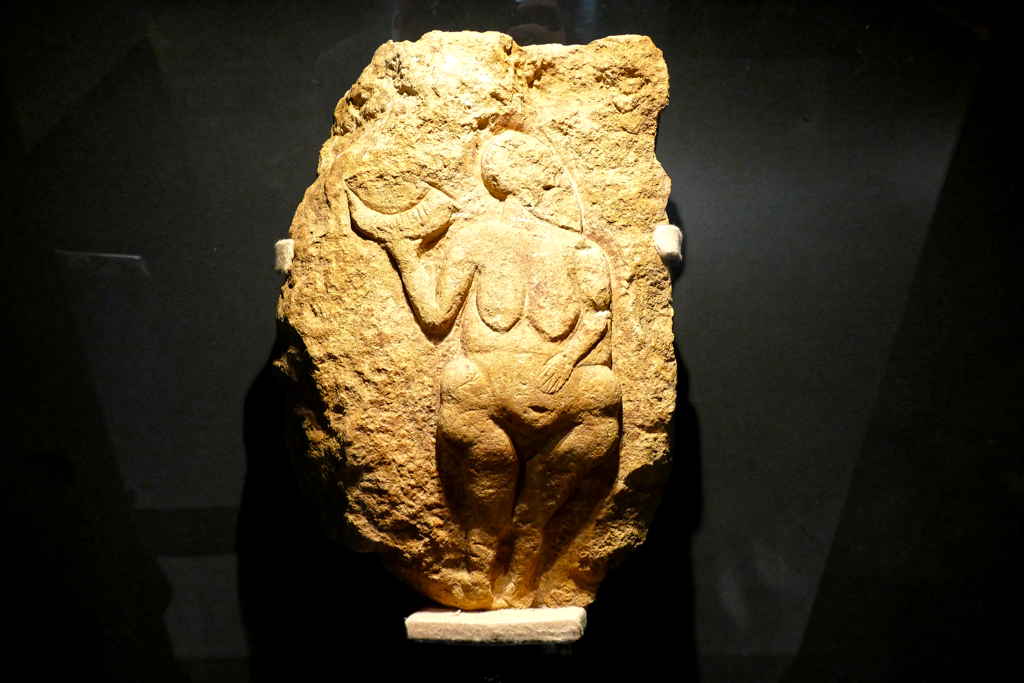
This being said, an exhibition on Bordeaux’s role in the Atlantic commerce including slave trade in the 18th century was added as the city has begun facing also its involvement in this dark chapter of French history.
The museum is located just a few minutes’ walk southeast of Place Pey Berland. For a general fee of 5 €uros, it can be visited from Tuesday to Sunday between 11 a.m. and 6 p.m. However, entrance is free CityPass** as well as on the first Sunday of each month except July and August.
Place du Palais And Porte Cailhau
The Porte Cailhau is the most beautiful gate in the old historic city center. Completed in 1496, it served as both a defensive gate and a triumphal arch.
Today, it adorns the east side of the Place du Palais, one of the city’s most lively outdoor nightlife spots.
The entire square is lined with relaxed cafés and bars, so you’ll be spoiled for choice where to rub shoulders with locals. The Place du Palais is certainly one of the best places to peer into the soul of Bordeaux.
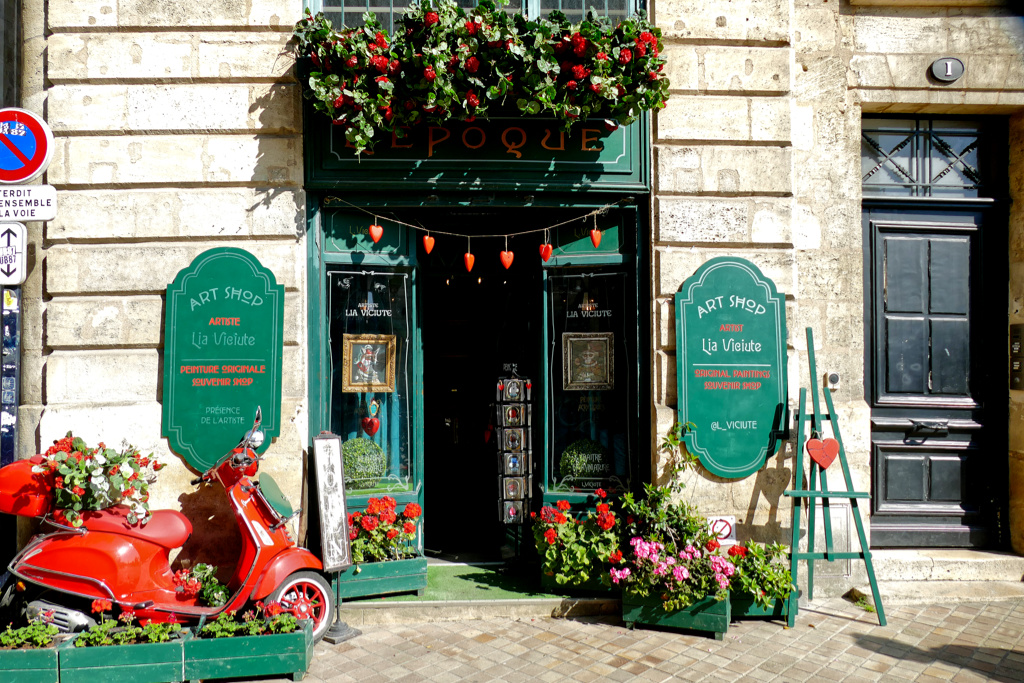
But the east side of the Porte Cailhau is also not to be underestimated, as it is home to Bordeaux’s lifeline, the Garonne River.
While you’re in the area, you should consider hopping on one of the excursion boats that travel up and down the Garonne several times a day during peak season. The trip lasts an hour and a half and is commented on in French and English by a passionate guide.
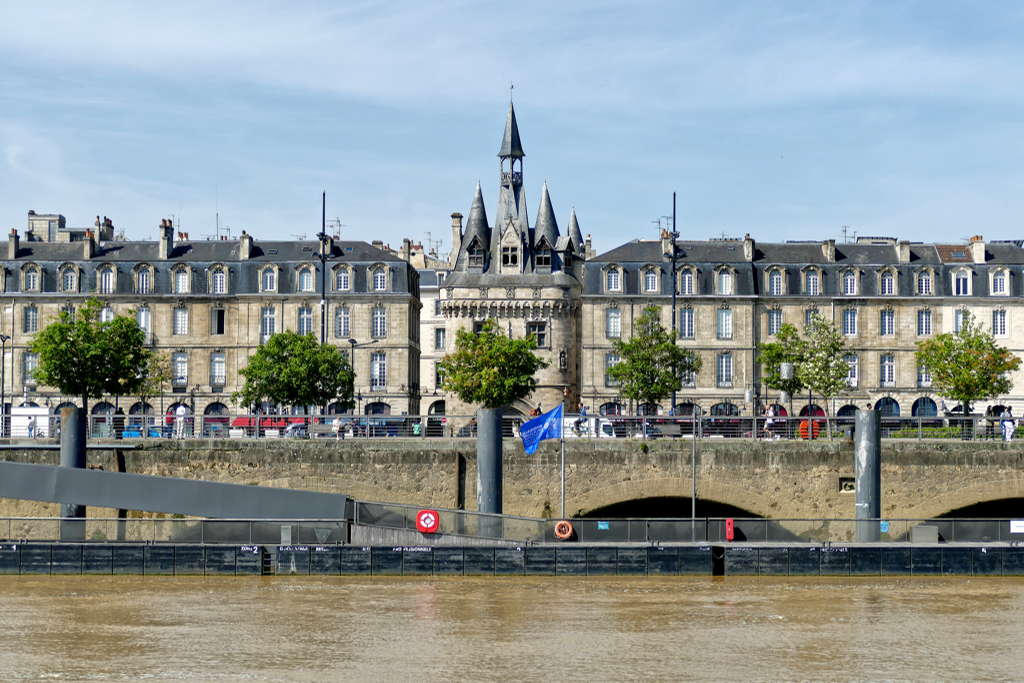
You’ll see the magnificent buildings on the left bank and the developing right bank alike. You’ll learn a lot about the city and will realize how undervalued it actually is. The fact that the price of 17 €uros also includes a drink of your choice and a local pastry, the deliciously chewy cannelé, is a charming extra.
The cruise on the Garonne is also included in the CityPass**, obviously, but here too, you have to book in advance at the tourist office.
Place de la Bourse And the Miroir d’Eau
Just a few steps north of the Porte Cailhau lies the majestic Place de la Bourse.
Jacques Gabriel designed the Place de la Bourse, hence, the stock exchange square, between 1735 and 1738. Eventually, it was his son, Ange-Jacques Gabriel, the chief architect of King Louis XV, who carried the project out.

Today, the square is one of the most representative works of 18th-century French neoclassical architecture. To the north stood the Palais de la Bourse, which is now the Bordeaux Chamber of Commerce and Industry. On the opposite side is the former Hôtel des Fermes, which houses the National Customs Museum.
Since 2006, the Miroir d’Eau, hence, the Water Mirror, covers an area of 3,450 square meters across from the Place de la Bourse on the bank of the Garonne. This shallow body of water reflects the majestic building complex. Its underground reservoir of 800 cubic meters makes it the largest of its kind in the entire world. Fountain engineer Jean-Max Llorca, architect Pierre Gangnet, and landscape architect Michel Corajoud designed a system where 2 cm of water on a granite slab creates an amazing mirror effect. Every now and then, there are huge clouds of mist rising up to two meters in height.
Place du Parlement
Two blocks west of the Place de la Bourse is another quaint, rather small square. Like the Place du Palais that I introduced above, the Place du Parlement invites you to take a short or longer break at virtually any time of day.
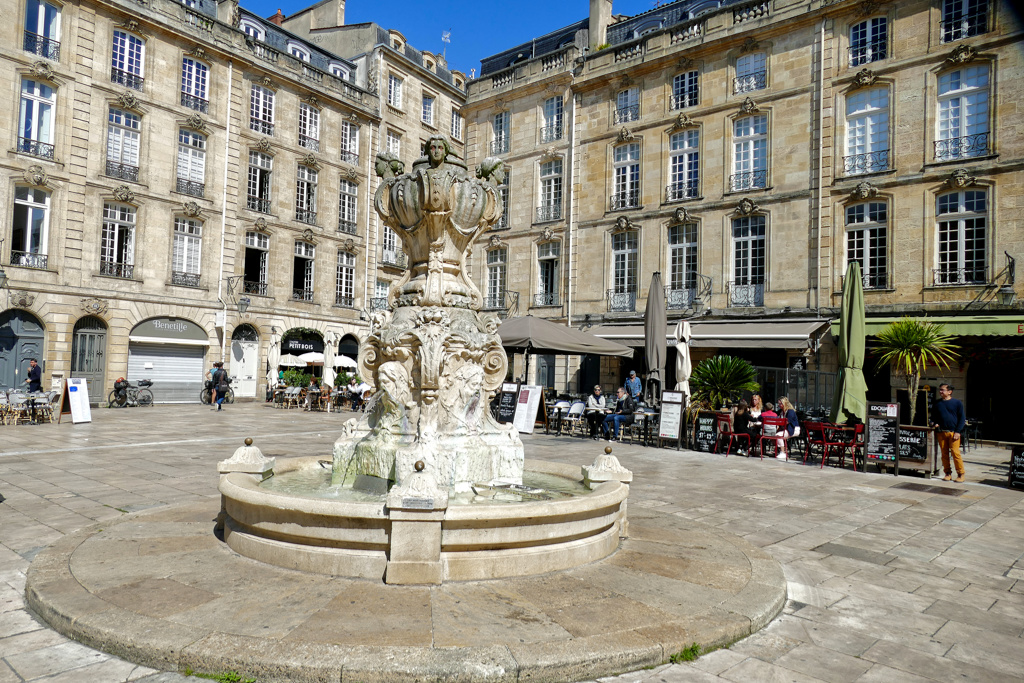
The Place du Parlement is a prime example of the architecture of Bordeaux’s Golden Age and a gem of urban planning. The buildings surrounding the square are constructed of the local honey-colored limestone typical of Bordeaux and feature elegant iron balconies, arched windows, and sculptural details that reflect the influence of Louis XV’s urban planning.
Place de la Comédie
The Place de la Comédie is just a few steps from the Place de la Bourse. This square is another architectural and cultural gem of the city and is surrounded by elegant buildings, cafés, and boutiques. It’s another ideal starting point for exploring Bordeaux’s mesmerizing city center.

At its center stands the impressive Grand Théâtre. Designed by Victor Louis, it was inaugurated in 1780. With its twelve Corinthian columns and statues of the nine Muses and three goddesses, Louis created a masterpiece of neoclassicism. Today, it houses the Opéra National de Bordeaux and the Ballet National de Bordeaux.
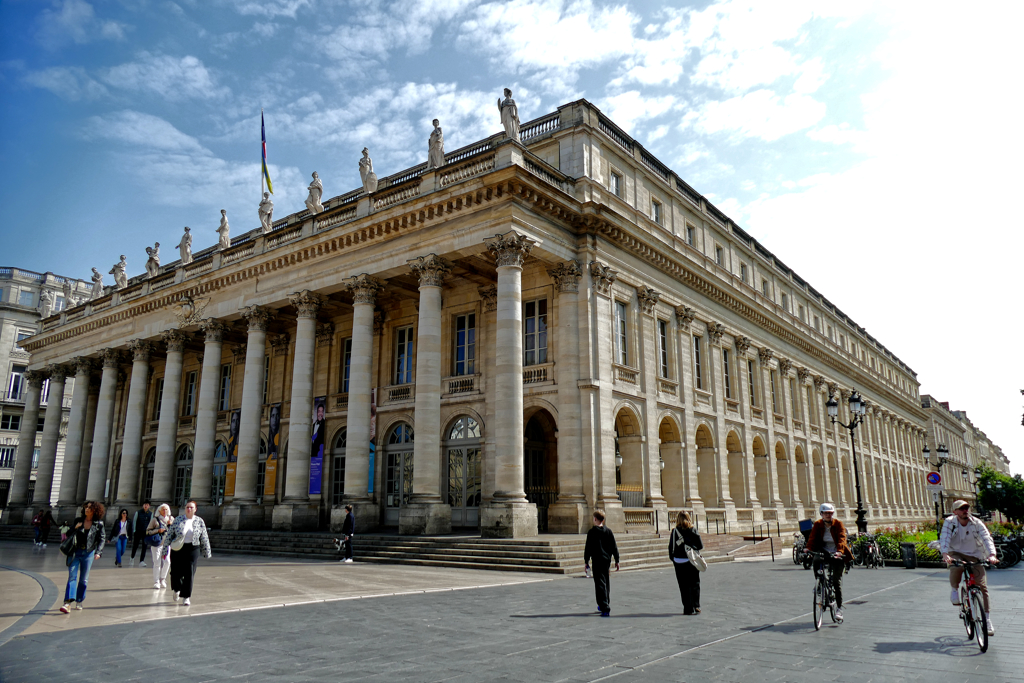
Directly opposite the theater is the Grand Hôtel de Bordeaux*, a luxurious 5-star hotel with an impressive facade. Originally, the magnificent building was not a hotel, but rather a representative building with residential and commercial spaces, in keeping with its prestigious location.
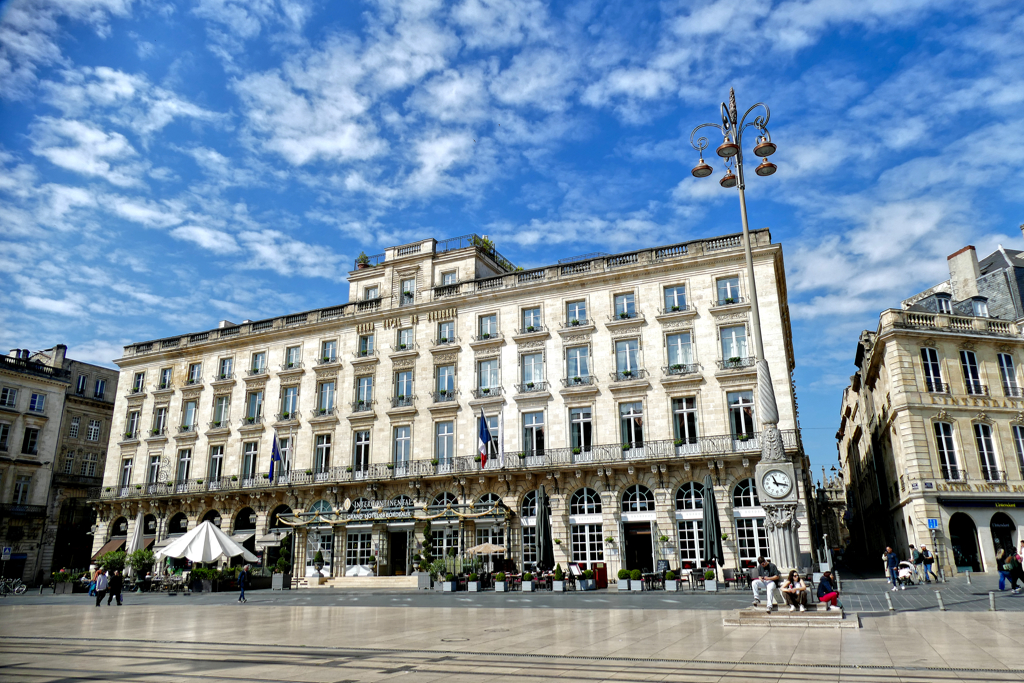
It was not until the 19th century that the building was converted into a hotel. After a turbulent history, it was finally extensively renovated and reopened in 2007 as the luxurious 5-star InterContinental Bordeaux – Le Grand Hôtel*. It houses restaurants by renowned chefs such as Gordon Ramsay and Philippe Etchebest. Also, it has an elegant rooftop terrace with spectacular views of the city.
La Maison du Vin
An intriguing structure at the eastern side of the square is the Hôtel Gobineau. Thibault-Joseph de Gobineau, a Bordeaux parliamentary councilor, commissioned it from the renowned architect Victor Louis in 1789.
The building is characterized by its striking, ship-like shape, stylistically inspired by the Flatiron Building in New York. This shape symbolizes Bordeaux’s maritime history and its role in international trade.
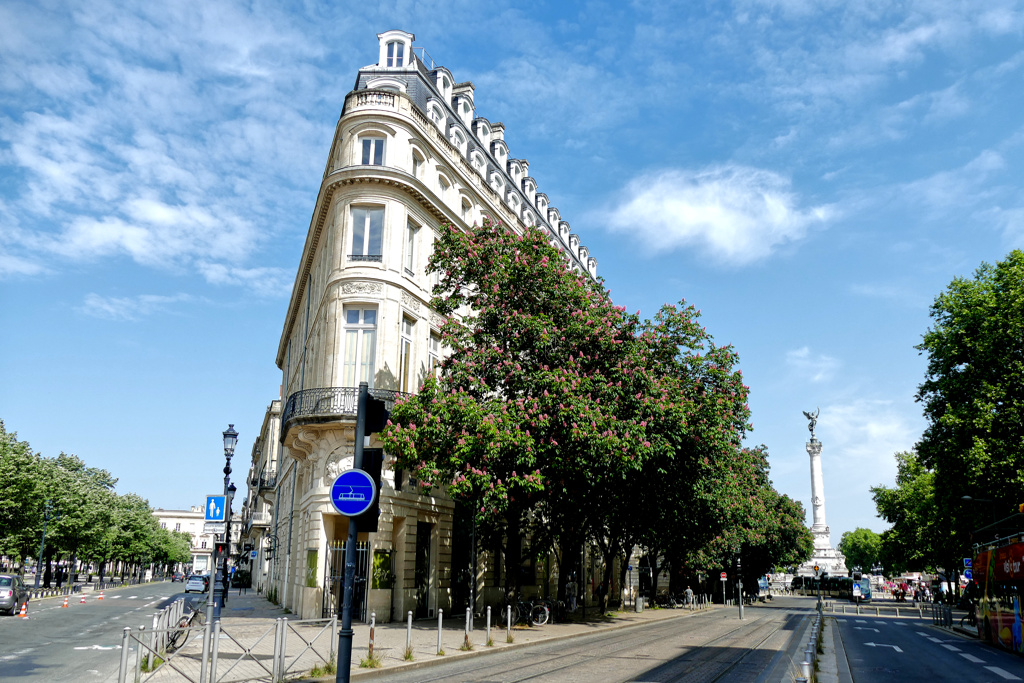
Originally designed as a private townhouse, the Maison Gobineau has had a varied history:
In the early 20th century, it housed a hotel with a café-restaurant on the ground floor. Eventually, the architect Raymond Mothe added two additional floors to the building in the 1920s. In 1925, part of the ground floor was converted into Bordeaux’s first Citroën car dealership.
Finally, the building became the headquarters of the Bordeaux Wine Interprofessional Council in 1948. It is now known as La Maison du Vin de Bordeaux.
The ground floor houses a public wine bar offering Bordeaux wines for tasting. The bar is also one of the stops on the so-called Urban Wine Trail. This trail connects 14 very different wine bars in the city, most of which are easily accessible on foot. This usage ensures that the Hôtel Gobineau remains an important symbol of the city’s wine and architectural history.
A Bordeaux CityPass** allows you to participate in a complimentary wine tasting at the Maison du Vin, however, you need to make reservation at the tourist office which is located just around the corner.
Place des Grands Hommes
The Place des Grands Hommes is a stylish square located in the heart of the prestigious Triangle d’Or, hence, the city’s proverbial Golden Triangle. It is flanked by Rue Voltaire, Rue Montesquieu, and Rue Condé. Although the names of these great men evoke historic relevance, the square itself is not that old. In fact, it was created at the end of the 20th century as part of an urban renewal project.
At its center is an elegant glass-domed shopping arcade with luxury boutiques, delicatessens, and chic cafés. The architecture combines classical symmetry with modern materials, creating a unique blend of tradition and contemporary design.

The area surrounding the square is one of Bordeaux’s most exquisite neighborhoods and is known for its neoclassical buildings, of which the former Théâtre Français is definitely the most impressive one.
Place de la Quinconces
And now we get to the greatest square in the whole city – and the largest one in all of Europe, for that matter! And if you wonder: It is followed by the Piazza del Prato della Valle in the Italian city of Padua and the Alexanderplatz in Berlin.
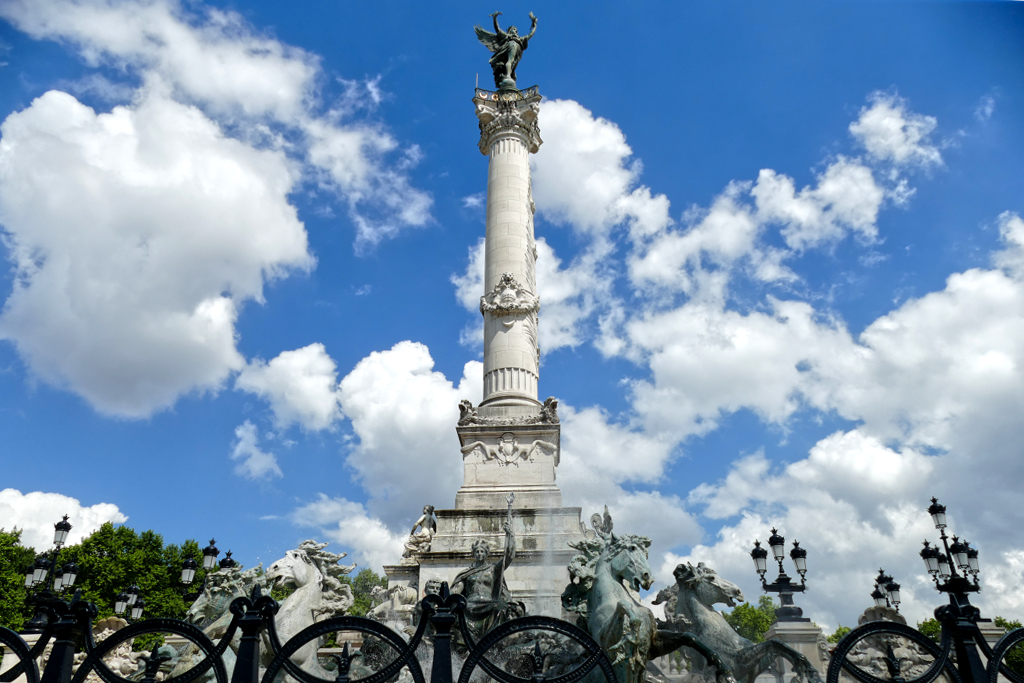
The square was created in the early 19th century on the site of the former Château Trompette. Initially named after the French rulers, it was known as Louis XVI Square, then Louis Philippe Square. It was only after the Second French Revolution in 1848 that the city gave the square its current name.
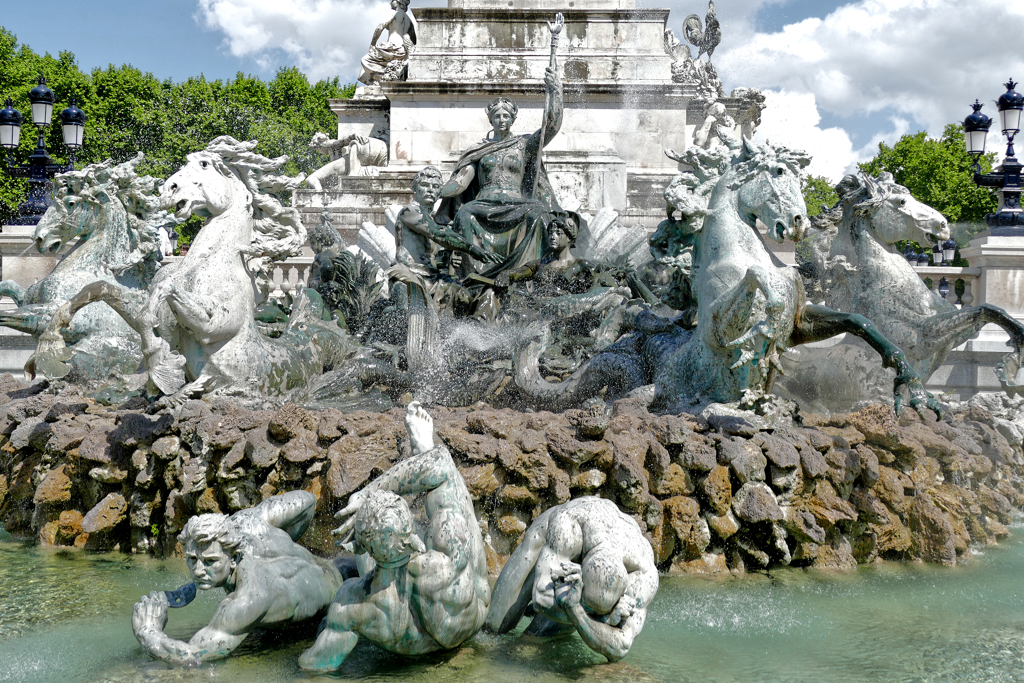
The large open space is used for events, sales promotions, and by fairground operators. On the eastern side are two magnificent columns with sculptures symbolizing trade and seafaring.

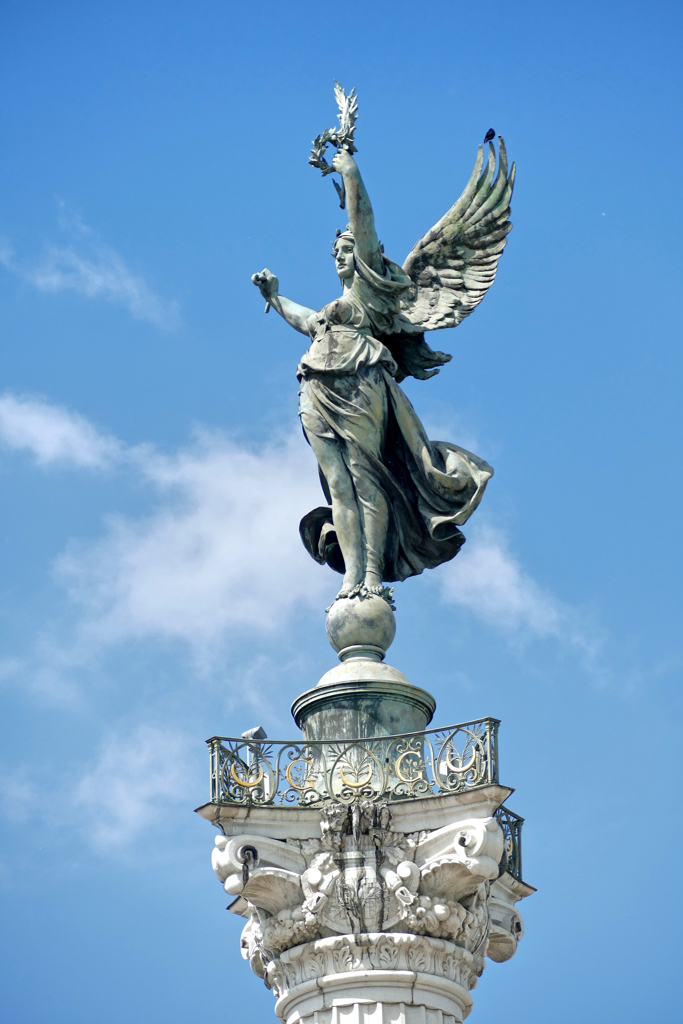
At the eastern edge stands the 43-meter-high Statue of Liberty, the Monument aux Girondins. During the occupation of the city in World War II, the Nazis removed large parts of the bronze figures from the monument’s fountain basin. They intended to use them for weaponery. Fortunately, the sculptures were rediscovered in Angers in 1945, but were not reinstated in their original location until 1983.
What does Place de la Quinconces mean?
When the square was created in 1818, trees were planted in patterns like the fives on dice. This pattern is called quinconce in French.
…and who were the Girondists?
The Girondists, who named themselves after the Gironde department, were a group of deputies during the French Revolution. Obviously, they came mainly from the southwest of France and belonged to the upper middle class. They first appeared in the Assemblée Nationale Législative, hence, the National Legislative Assembly, in 1791.
There, they found majorities for the abolition of the monarchy, but also for a declaration of war on Austria. The uprising of the so-called Sansculottes, hence., workers and members of the lower middle class, led to the arrest and execution of leading Girondists in 1793.
Chartrons
The district of Chartrons borders the Place de la Quinconces to the north. It is a historic neighborhood that played a pivotal role in establishing Bordeaux as a famous wine hub. Named after the Carthusian monks who settled there in the 14th century, Chartrons flourished in the 17th and 18th centuries as merchants established wine trading houses in the area.
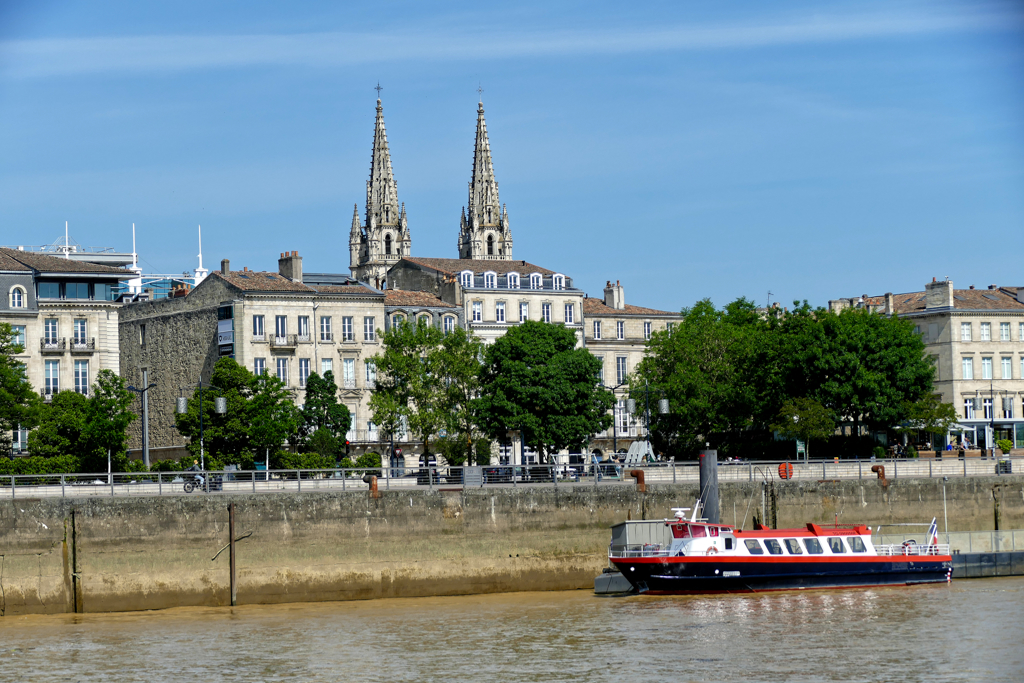
Today, Chartrons exudes a bohemian charm, with antique shops, art galleries, and chic cafés lining its streets. Also, you’ll find some of Bordeaux’s best street art on the walls of Chartrons. I’m introducing it in my post BORDEAUX: Best Street Art on the Left Bank of the Garonne.

The riverside part of the district was transformed as part of Bordeaux’s redevelopment project. Old warehouses were restored and converted into offices, upscale boutiques, and waterfront restaurants. Today, you can enjoy a leisurely stroll or bike ride along the quay.
Cité du Vin
Wine in Bordeaux is serious business. After all, it was this fine grape juice that brought the city fame and, above all, wealth. Consequently, the Cité du Vin is far more than just a museum. It’s a monument to wine culture in all its diversity and depth. Opened in 2016 on the banks of the Garonne River, this striking building stands as a symbol of Bordeaux’s proud identity as a global wine capital. It’s designed to be immersive, sensory, and global in scope. It is undoubtedly an essential stop for wine lovers and curious travelers alike.

The architecture of La Cité du Vin is bold, fluid, and unmistakable. Designed by XTU Architects, its shape evokes swirling wine in a glass, the twist of grapevines, and the eddies of the Garonne River nearby. Covered in shimmering, reflective glass and perforated aluminum, the building changes color with the light from golden to silvery, or even greenish. This way, it echoes the hues of white wine. Also, the inside is dominated by flowing, organic shapes. There are no straight lines in sight.
Hands On
The permanent exhibition covers an incredible 3,000 square meters and offers an interactive, multimedia, multisensory journey. It covers the history of wine from ancient civilizations to modern times and the role of wine in different cultures and religions. You get to explore the
geography not only around Bordeaux, but also of wine regions across the globe.
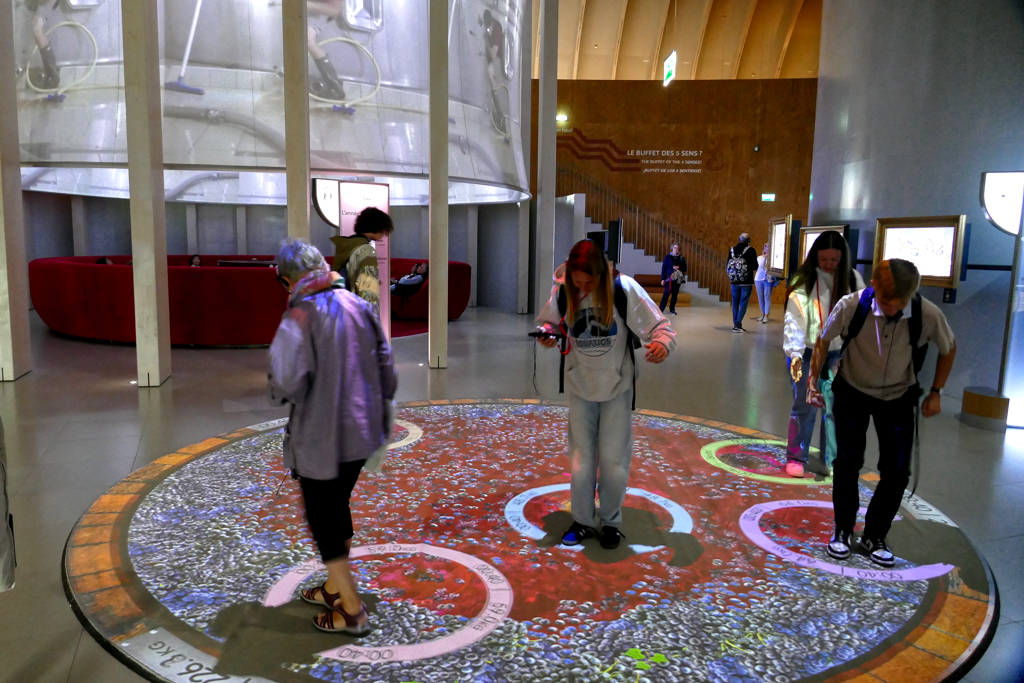
The so-called Wine Buffet of the Senses allows you to explore aromas, textures, and flavors. Hence, you don’t need to be a wine expert to enjoy the exhibitions, as the space is designed for both amateurs and connoisseurs.

Of course, your ticket also includes a glass of wine at the Belvédère, the panoramic top-floor bar, with a stunning view of the city and the Garonne. If you want to shop for wine, you can do so at their boutique that holds wines from over 80 countries in store.
The venue is open every day from 10 a.m. to 7 p.m. and the general admission to the permanent exhibition is 22 €uros with a date-stamped ticket and 27 €uros with an open ticket.
However, the visit is free with the Bordeaux CityPass**.
Bassins des Lumières
Another major attraction, not just for tourists, is the so-called Bassins des Lumières. It is located somewhat outside the direct city center, but is easily accessible by bus #9.
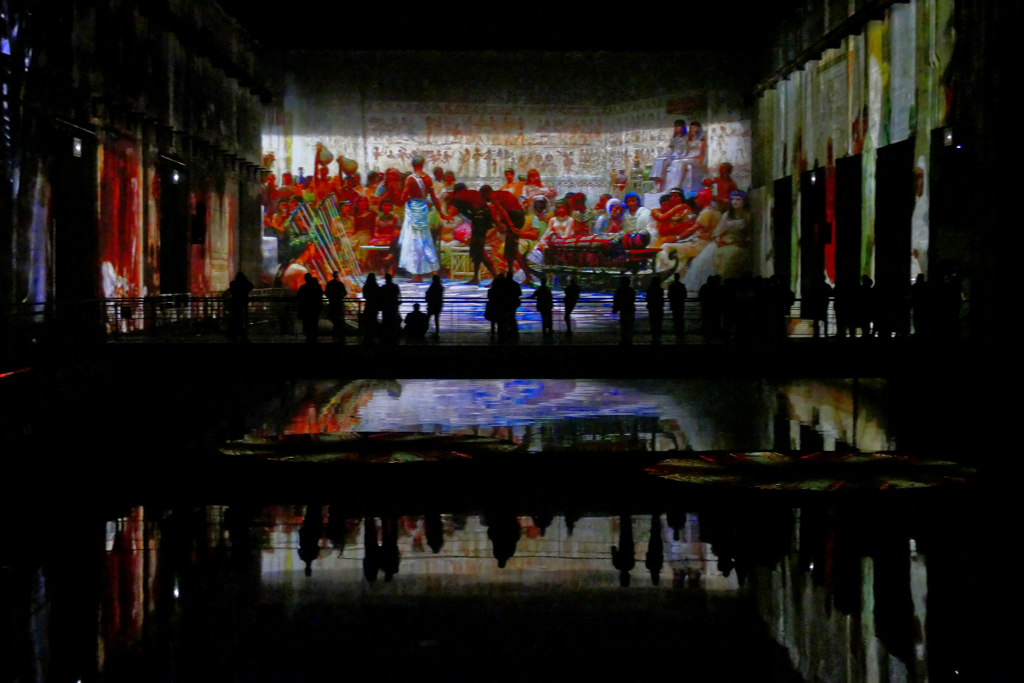
The building housing the Bassin des Lumières is a former German submarine base. The Nazi navy constructed the base between 1941 and 1943 during World War II to host and protect their submarines from bombing raids. The whole structure is over 20 meters high and 245 meters long. Inside, thick concrete walls separate five enormous basins.
After the war, the base remained largely unused for decades. However, already then, it occasionally served as a venue for contemporary art.
Let There Be Light
In 2020, the city of Bordeaux converted the site into a high-tech art center. Using video projectors, sound systems, and mirrored reflections on the water, the space became an immersive canvas for digital exhibitions. Hence, it is a mesmerizing fusion of art, architecture, and technology. Until now, masterpieces by world-famous artists have rippled across the walls and water surfaces. Each show was accompanied by a carefully composed soundtrack, making the experience multisensory.

Currently, they are showing the mysterious world of ancient Egypt’s pharaohs as well as works by French Orientalists from the 19th century.
Especially the dark history of the building, combined with 21st-century digital art, is a truly unique experience as the ambiance inside the former submarine base is both haunting and poetic.
The venue is open every day from 10 a.m. to 7 p.m. and the general admission is 16 €uros. Note that you cannot pay in cash but only by credit card. However, also this visit is free with the Bordeaux CityPass**.
There’s More
Basically all the squares and landmarks presented above are located right in the heart of Bordeaux. They’re surrounded by hotels, restaurants, and shops, and you won’t have any trouble finding them. However, I’d like to point out three other districts that aren’t exactly remote. Nevertheless, they’re more local, residential neighborhoods that don’t always attract visitors. And that’s precisely what makes the latter two so charming and absolutely worth seeing.
But let’s start with Mériadeck.
Mériadeck
Mériadeck stands as Bordeaux’s bold foray into modernist urban planning. Originally a marshland, the area was developed in the 18th century by Cardinal Ferdinand Maximilien Mériadec de Rohan, who initiated the construction of the Palais Rohan, now the city hall. By the mid-20th century, Mériadeck had deteriorated into a slum. In response, Mayor Jacques Chaban-Delmas spearheaded a radical redevelopment in the 1960s, envisioning a futuristic district characterized by high-rise buildings, elevated walkways, and a clear separation of pedestrian and vehicular traffic.
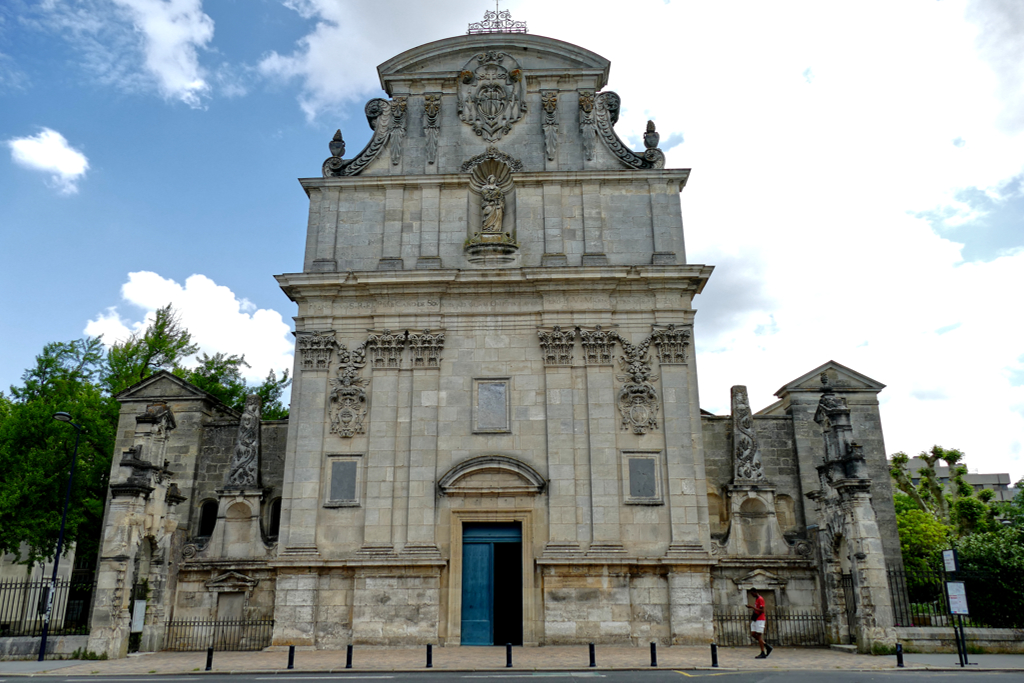
The result was a concrete landscape of administrative buildings, residential towers, and commercial centers, including the Mériadeck Shopping Centre and the Patinoire de Mériadeck ice rink . While the district’s brutalist architecture contrasts sharply with Bordeaux’s historic charm, it represents a significant chapter in the city’s evolution.
Why Go?
You’re probably wondering why I’m presenting such a relatively unattractive neighborhood when there’s so much stunningly beautiful to see in Bordeaux. And you’re right. However, a trip to the Mériadeck neighborhood is worthwhile if you’re interested in street art. In my post BORDEAUX: Best Street Art on the Left Bank of the Garonne, I present murals commissioned by the Gironde Department Council that now adorn its headquarters.
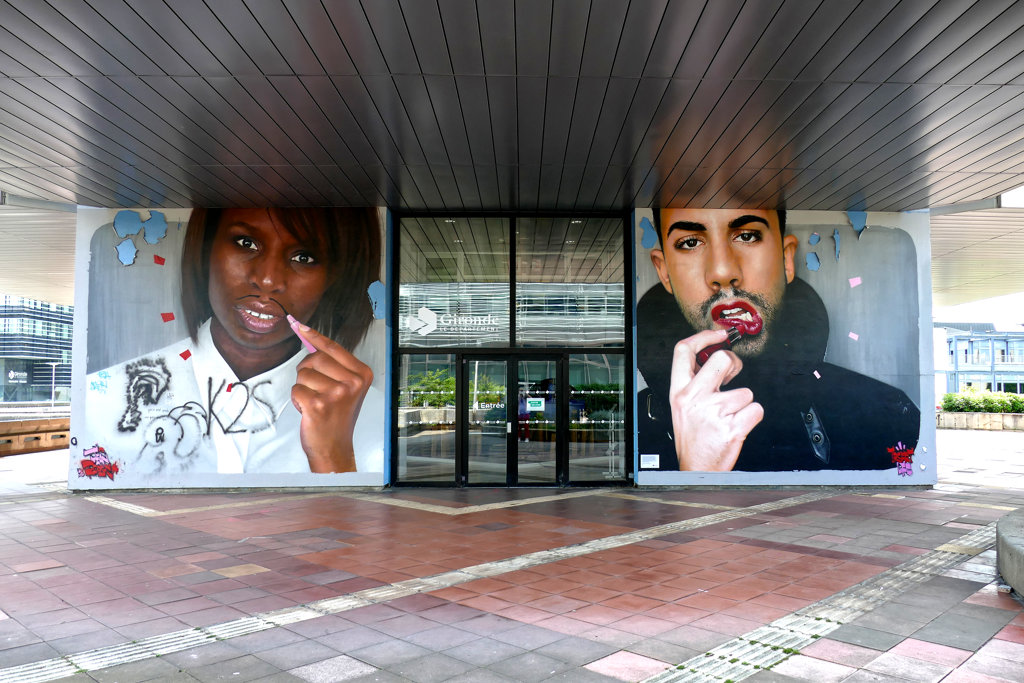
On the other hand, Mériadeck is highly recommended if you’re looking for good, yet affordable, no-frills accommodation. Around the shopping center, you’ll find several chain hotels that offer functional rooms at a reasonable price, yet you’re still just a few minutes’ walk from the historic center.
But if you’re not interested in street art and can afford stylish accommodations in a charming neighborhood, you can safely skip a visit to the neighborhood of Mériadeck.
Saint-Seurin – Fondaudège
Saint-Seurin – Fondaudège is a tranquil neighborhood steeped in history. The area is home to the Basilique Saint-Seurin, a UNESCO World Heritage site with origins dating back to the 6th century. Nearby lies the Palais Gallien, the remnants of a Roman amphitheater, offering a glimpse into Bordeaux’s ancient past.
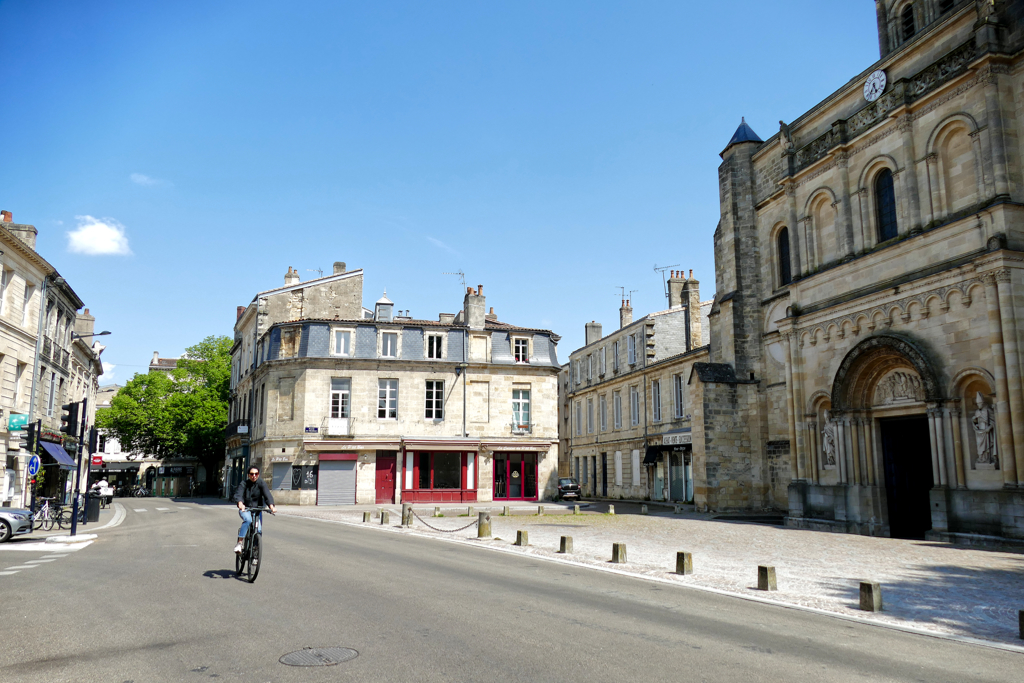
Fondaudège Street is a lively thoroughfare lined with boutiques, bakeries, and cafés, embodying the neighborhood’s blend of historical charm and modern living. The area’s peaceful ambiance and rich heritage make it a favorite among families and history enthusiasts alike.
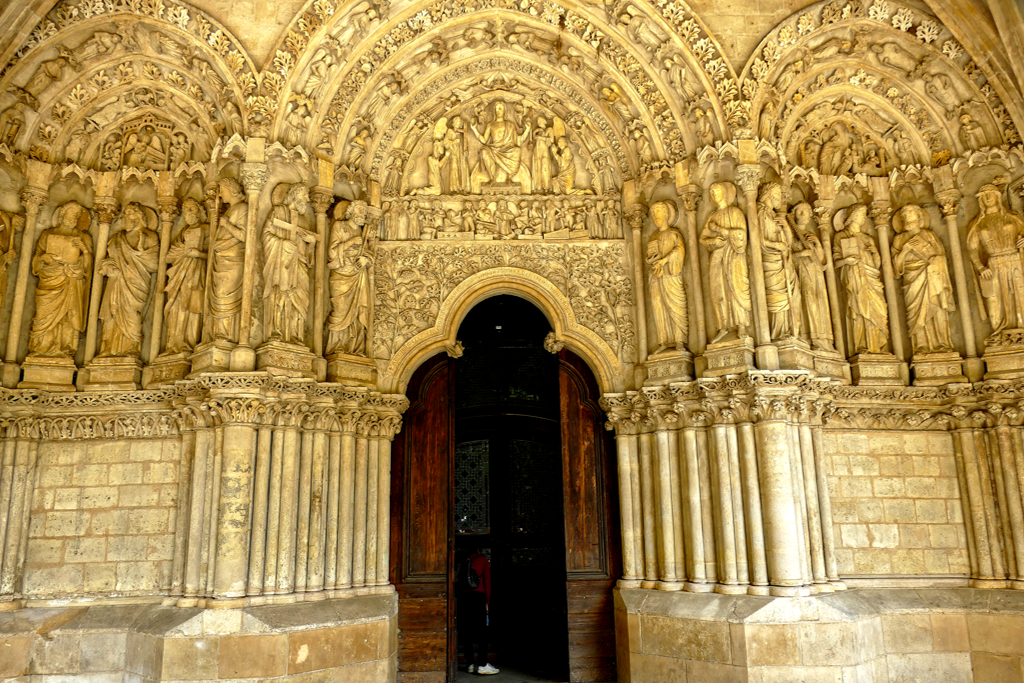
It’s also just a stone’s throw from the Jardin Public, Bordeaux’s green lung in the heart of the city center. So if you’re looking for some peace and quiet from the sightseeing, the park’s cafés are a lovely retreat.
Saint-Michel
Saint-Michel is one of Bordeaux’s most dynamic and diverse neighborhoods. At its heart lies the Basilique Saint-Michel, a Gothic masterpiece constructed between the 14th and 16th centuries, notable for its separate bell tower.
The area is mostly renowned for its multicultural atmosphere, with a plethora of international eateries, vibrant markets, and eclectic shops. I simply love it here.

One of its central points is the Marché des Capucins, often referred to as the proverbial Belly of Bordeaux. It is a bustling farmers’ market offering a wide array of fresh produce, meats, and local delicacies. Actually, it’s one of my favorite places in the city, and I never skip a visit when I’m in town.
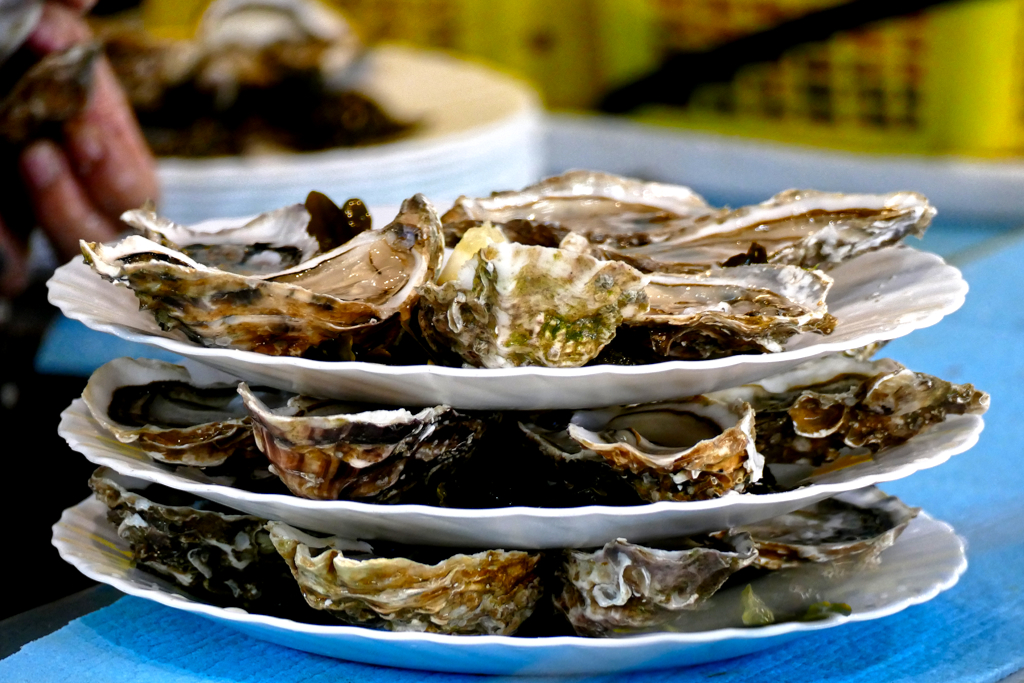
This being said, the Marché des Capucins is far from being an affordable source of produce for many of the long-established residents, many of whom emigrated from France’s former colonies.
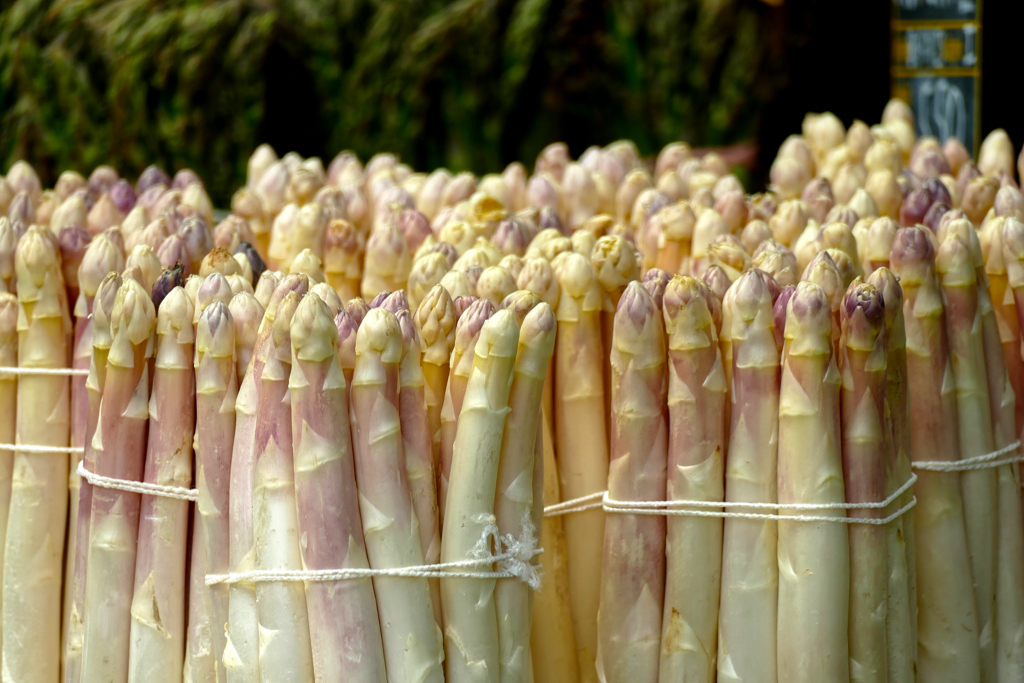
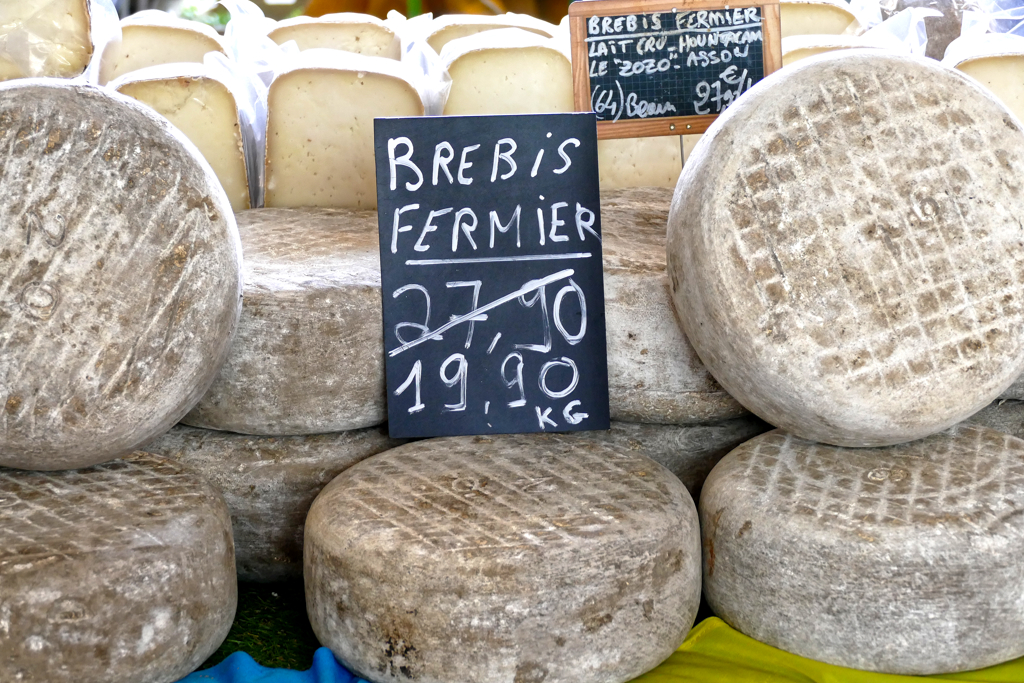
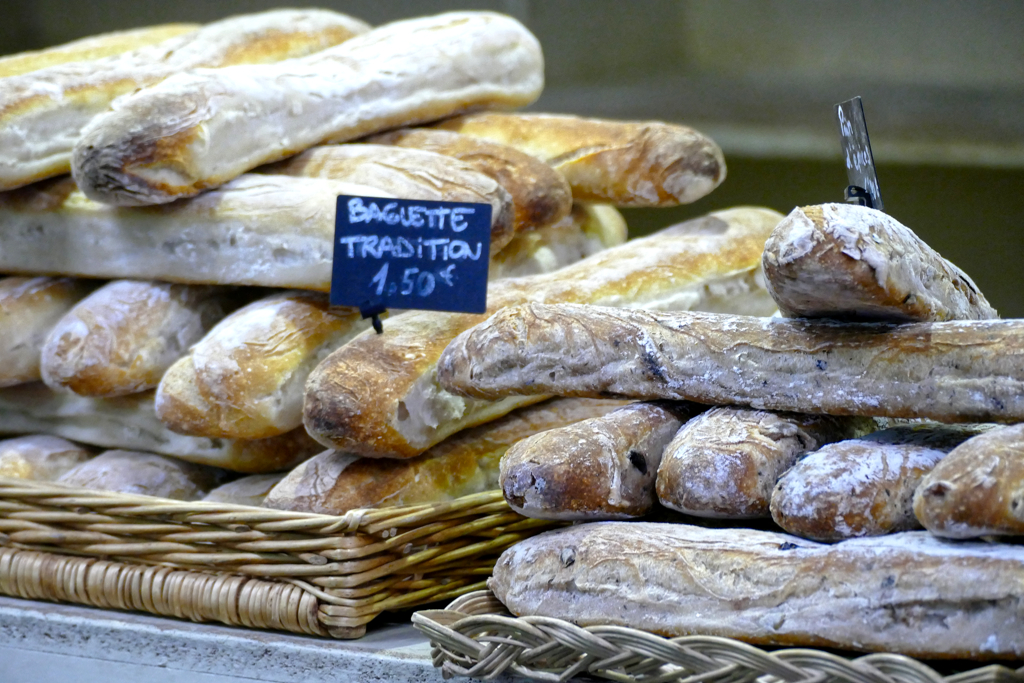
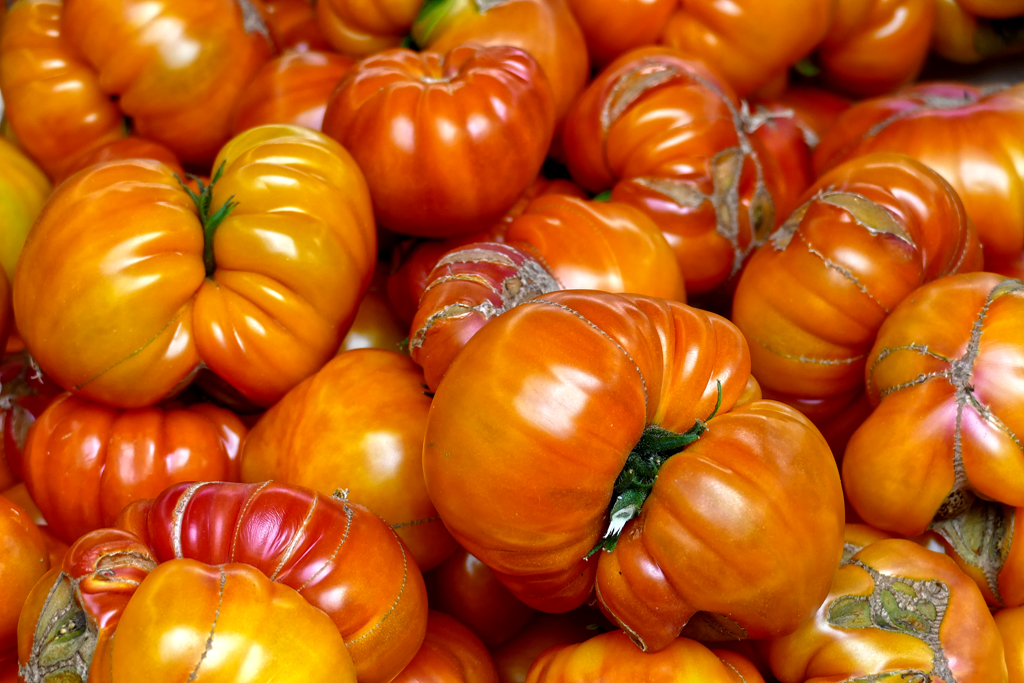
They certainly lack the means to purchase the first-class, high-priced goods on the Marché des Capucins. For them, street vendors set up their fruit and vegetable stalls on the Place Canteloup in front of the Basilique Saint-Michel. So if you want to be part of the hustle and bustle, take a front seat on the terrace of one of the surrounding bars on a Saturday morning, order a cup of coffee or mint tea, and enjoy some exciting people watching.
On the Right Bank of the Garonne
Historically, the districts on the right bank of the river Garonne were characterized by industrial facilities, including chemical plants and warehouses. Over time, these industries declined, leaving behind underutilized spaces. Recognizing the potential for revitalization, city planners initiated comprehensive redevelopment plans to breathe new life into the area. Since then, construction has been rampant. Therefore, it’s not really relevant for the average visitor, except for the creative hub called Darwin.
Darwin Ecosystem
Located within the Bastide district, the so-called Darwin Ecosystem is a pioneering project that exemplifies sustainable urban regeneration. It all began in 2011 with the transformation of the former Niel military barracks into a multifunctional space dedicated to ecological and social innovation.

Today, the so-called Darwin hosts over 100 enterprises and associations, providing collaborative workspaces that support startups and social entrepreneurs committed to sustainable practices. The site includes also art galleries, venues for concerts and events, and a large skatepark.

Its organic restaurant, grocery store, and markets promote local and sustainable products. But as is always the case with such projects, at the end of the day they are aimed at a rather privileged group of residents.
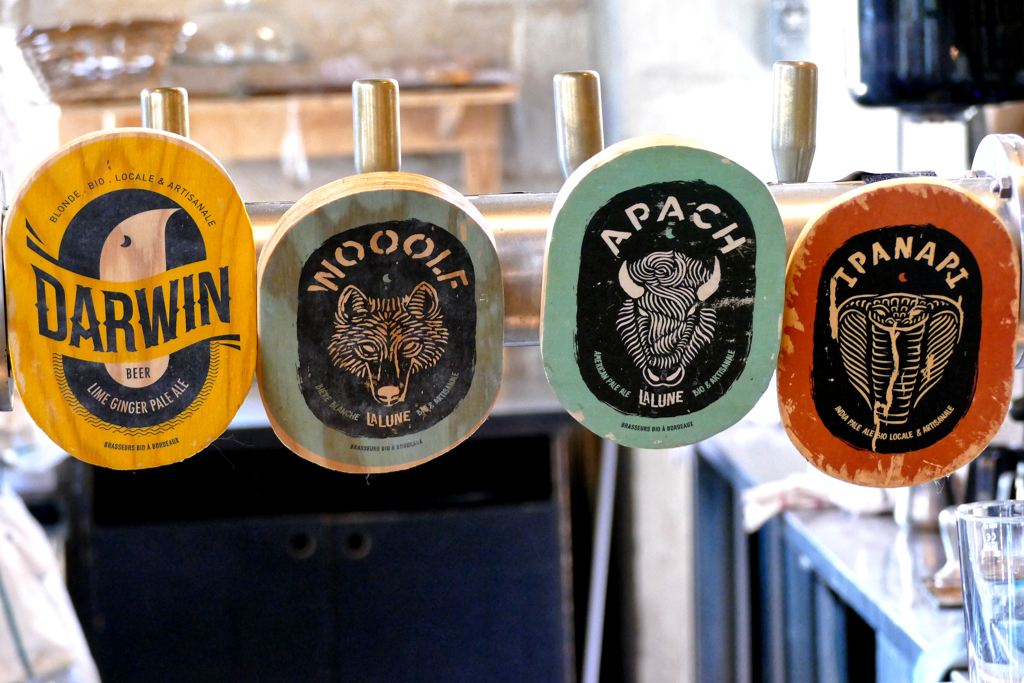
I paid almost 9 €uros for a beer at the Darwin. That’s a lot of money for many people. It would be so cool if the Darwin Project also appealed to people outside of a high-income bracket that can afford this level of discretionary consumption.
Why Darwin?
The project’s founders were inspired by Charles Darwin’s theory of evolution and his idea of adaptation to external conditions. Therefore, they chose his name to reflect the idea that businesses and individuals must adapt and evolve to thrive in the context of sustainable development and the circular economy.
So, those were the sites’n’sights you shouldn’t miss during your visit to Bordeaux.
Nevertheless, the most important thing is missing from this list: the flair, the inspiration, the kir on the terrace of a chic café, browsing in cute little shops, strolling along the cobblestone streets, relaxing under the trees in parks.
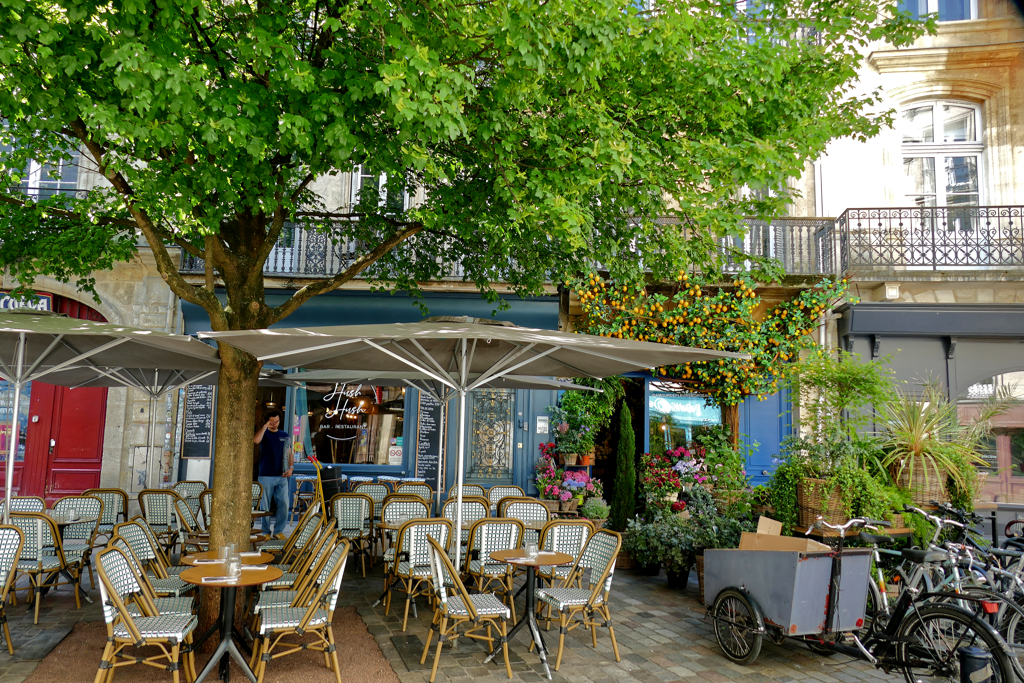
Despite its beauty and breathtaking architecture, Bordeaux is not some open-air museum. It is a city you should enjoy with all your senses.
That’s the only way to discover its soul and its captivating je ne sais quoi.
Soyez bienvenue!
Practical Information
How To Get There
Flight
Bordeaux’s airport is located in the Mérignac district, about ten kilometers west of the city center. Although it’s the quietest airport I’ve ever been to, it has an impressive number of international flights to many European destinations. This is primarily due to low-cost carriers like the Spanish airline Volotea. However, flights with major airlines like Air France and KLM usually require a transfer in Paris or Amsterdam.
Tram line A takes you to and from the airport. It runs at short intervals and stops at many key points throughout the city. However, above all, it costs only an incredible 1.90 €uros. Despite this convenience, you should plan on about an hour’s travel time.
Train
A major transportation hub is the Bordeaux Saint-Jean train station. Trains depart from here in all directions. For example, the TGV express train takes you to Paris in just over two hours, avoiding the need to fly. However, the SNCF’s fares aren’t particularly reasonable, and strikes are one of the favorite pastimes of many French people, which can make traveling by train somewhat unpleasant. Tickets can be purchased at stations or online; the SNCF website is available in French, English, German, Flemish, Italian, and Spanish.
As in many French cities, the train station is not directly in the city center, but rather on the outskirts. However, tram lines C and D, which stop right in front of the station building, will quickly take you to your final destination.
Bus
Flixbus is conquering the world, hence, it’s also serving Bordeaux. It might not be the fastest way to travel, but it’s quite comfortable and definitely the cheapest. For instance, a one-way trip to Paris takes seven to eight hours, but tickets start at 25 €uros. International tickets to, for instance, Barcelona or Madrid are around 40 €uros and the trips take nine to ten hours.
To check all their schedules and prices, visit their website.
The Flixbus stop in Bordeaux is on Halte Routière Paludate, on the left bank of the Garonne, close to the Pont Saint-Jean.
How to Get Around
Walking’N’Cycling
The fact that I’m listing almost all the places of interest one after the other, without mentioning any public transport links, shows you how easy it is to explore the city on foot. With a few exceptions, you can easily walk everywhere. It’s even faster, of course, by bike. On the one hand, Bordeaux strives to be a bike-friendly city. There are even retrofitted bike paths in the old quarter. And the bike paths along the Garonne are unbeatable, anyway.
The only literal stumbling block is the tram tracks. As great as the tram is and as much as its ringing charmed me every day, the tracks are a terrible trap. In the few days I was in Bordeaux, I witnessed two bike accidents, one of which seemed quite serious. So be very cautious when cycling next to those tracks.

However, you can rent a bike through the Le Vélo par TBM service. This service allows you to discover Bordeaux in an eco-friendly and convenient way. Bikes can be picked up at more than 180 stations throughout the city. They have both, conventional and electric bikes. As in most places, the first half hour is free, then you’ll be charged two €uros per hour. You can pay by credit card or a TBM subscription, which you probably won’t have if you’re in Bordeaux just for a couple of days.
Public Transport
Bordeaux boasts an efficient and user-friendly public transportation system. The network includes four tram lines, a wide array of bus lines, as well as the Bat³ river shuttle.

A single ticket costs 1.90 €uros and is valid for unlimited travel within one hour across trams, buses, and the Bat³.
A two-trip ticket costs 3.30 €uros, and each trip is valid for one hour.
There is also a ten-trip ticket for 15.00 €uros, however, I’d argue that the 24-hour pass for only 6.50 €uros, the 48-hour pass for 11.00 €uros, or the 72-hour pass for 13.50 €uros are might be a much better deal as they grant unlimited travel.
If you are planning on staying more than three days, the 7-day pass for 17.00 will be a suitable option.

Tickets are available at machines at tram stops, at TBM agencies, select newsstands, and most conveniently on the TBM app.
However, keep in mind that you have unlimited use of public transport with your Bordeaux CityPass**!
Don’t forget to validate your ticket each time you’re boarding a vehicle!
Visiting Organized
I’m an avid solo-travelling woman. Since solo travel doesn’t equal solitude, I love to join organized tours here and there. Not only do they allow me to meet fellow travellers, but they also provide me with valuable information and, oftentimes, fun stories that make my visit even more enjoyable.
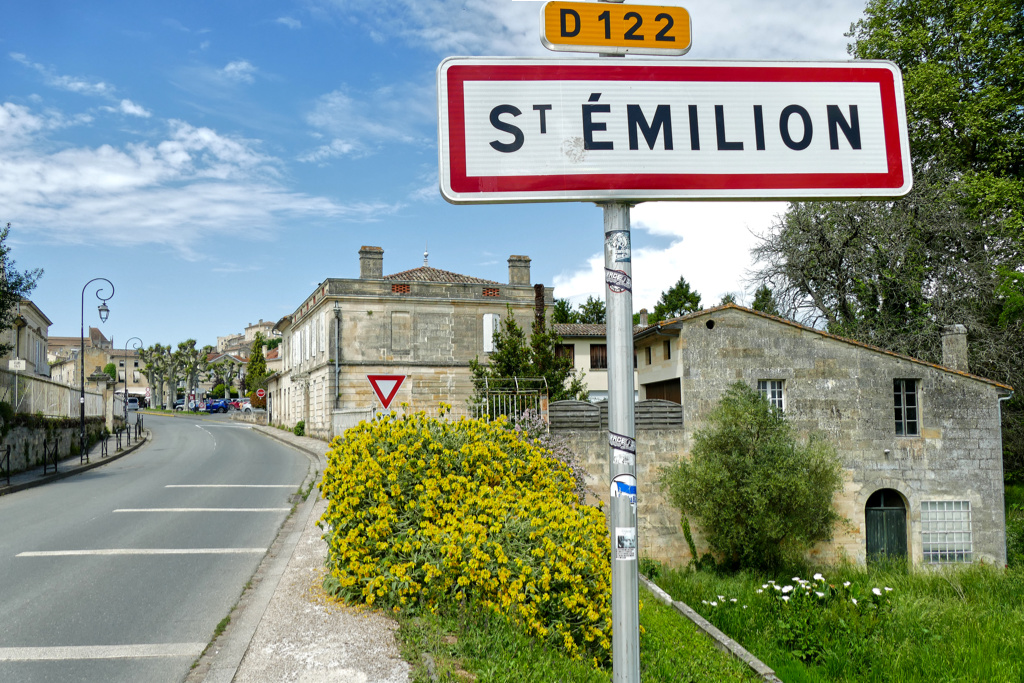
Therefore, here are some great ideas of what to do during your stay in Bordeaux. Especially if you have only a short amount of time, they’ll enable you to leave the planning and organizing to others and just enjoy the city and the surrounding area to the max*:
Where to Stay
Although Bordeaux is not as crazy expensive as Paris, accommodation is not exactly cheap. However, there are a surprising number of chain hotels in France, such as Accor, Campanile, Odalys, and others. While these hotels are more functional than pretty, they serve their purpose for budget-conscious travelers. Rooms are often available starting at about 50 €uros and are sometimes even equipped with a kitchenette. In addition, a fairly good, extensive breakfast is often offered for 12 to 15 €uros. If you want more than a croissant and a cup of coffee in the morning, this is definitely a good deal.
However, this is really only a tip for those who want to save money and for whom stylish accommodations aren’t that important. If you can splurge, there are, of course, also great lodging options with excellent service and superior comfort, such as the InterContinental Bordeaux – Le Grand Hôtel*.
You will certainly find a suitable lodging option on this map*:
What to Eat
On the way from Paris to Saint-Émilion, I have a two-hour train transfer in Bordeaux. “Let’s have lunch together,” suggests Philippe. “Right across from the station is Bouillon Saint-Jean. They are good and not expensive at all.” And so I not only discover a highly recommended restaurant, but also learn that the word bouillon doesn’t just refer to soup.
In fact, a so-called Bouillon is a simple, traditional restaurant that boasts a small menu at very reasonable prices.
Yes, and sometimes they even serve bouillon.

French food is famous for a reason. In fact, it is an important part of daily life in France, and regional cuisines and customs are a cherished part of the national culture. UNESCO recognized France’s efforts and designated the country’s national cuisine as an intangible cultural heritage in 2010.
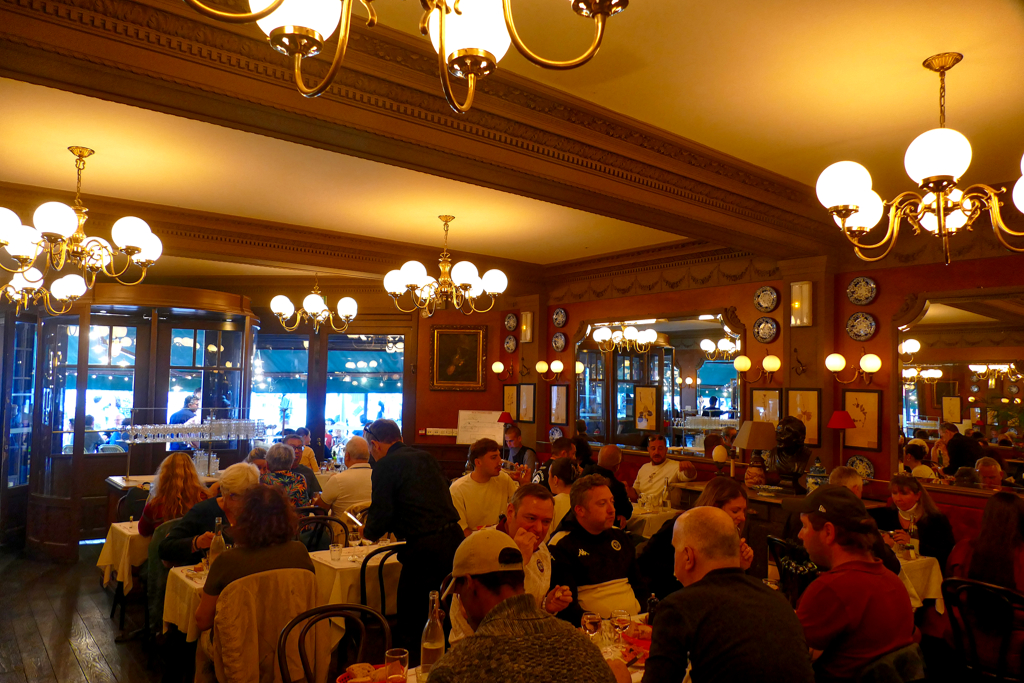
French cuisine is famous for its sophistication and versatility, and, most importantly, the high quality of the ingredients. Obviously, each region has its own specialties, but they are often popular throughout the country.
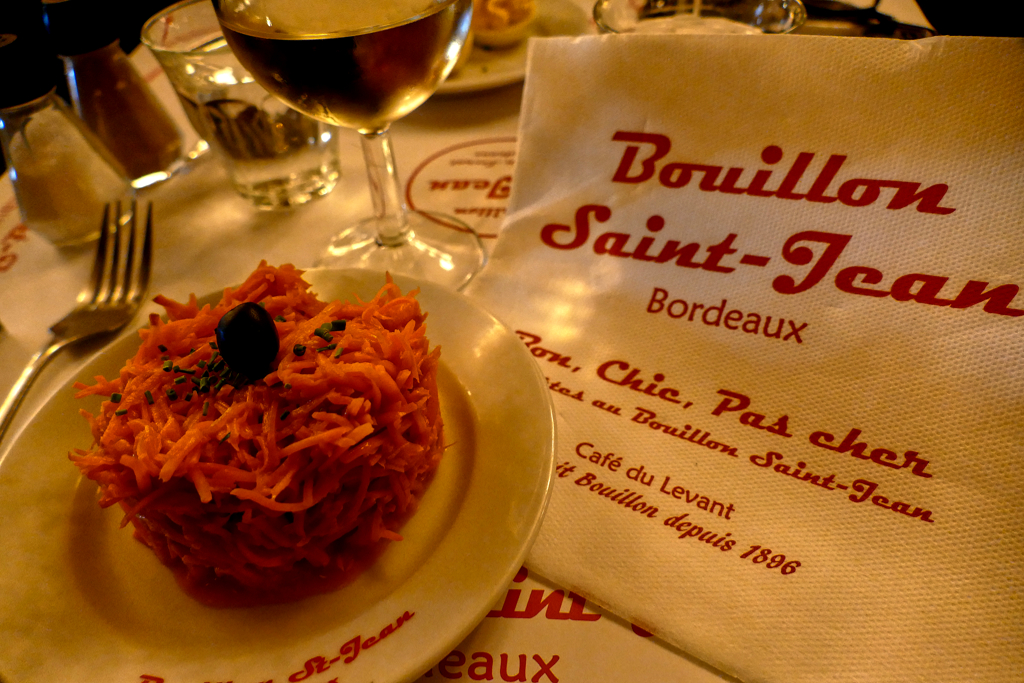
In addition to delicious wine and crispy baked goods, more than 700 types of cheese are particularly noteworthy! And the French don’t just slap cheese on a sandwich. They also use it a lot for cooking, gratinating, or as a filling.
Unfortunately, food in France is not cheap. Delicious snacks at reasonable prices are often available in bakeries and rotisseries as well as in eateries at farmers’ markets and in covered market halls. In general, lunch menus and daily specials, so-called plat du jour, are comparatively reasonably priced.
Regional Delicacies
The cuisine in the southwest is sophisticated, but also quite hearty. Whether it’s Pauillac lamb, raised in the Médoc and popular for its tender, finely marbled meat, or Boeuf de Bazas, beef renowned for its tenderness and flavor. Due to the proximity to the ocean, fish dishes are also on the menu, obviously. Especially popular is lamprey, a traditional dish in Bordeaux which is often prepared with Bordelaise sauce.

The proximity to the Atlantic coast ensures that oysters from the Bay of Arcachon are basically a staple and not such an exceptional delicacy as elsewhere. The same applies to foie gras, hence, fat goose liver. It is an integral part of Bordeaux cuisine and truly delicious—if you can ignore how much the animals have to suffer for it.
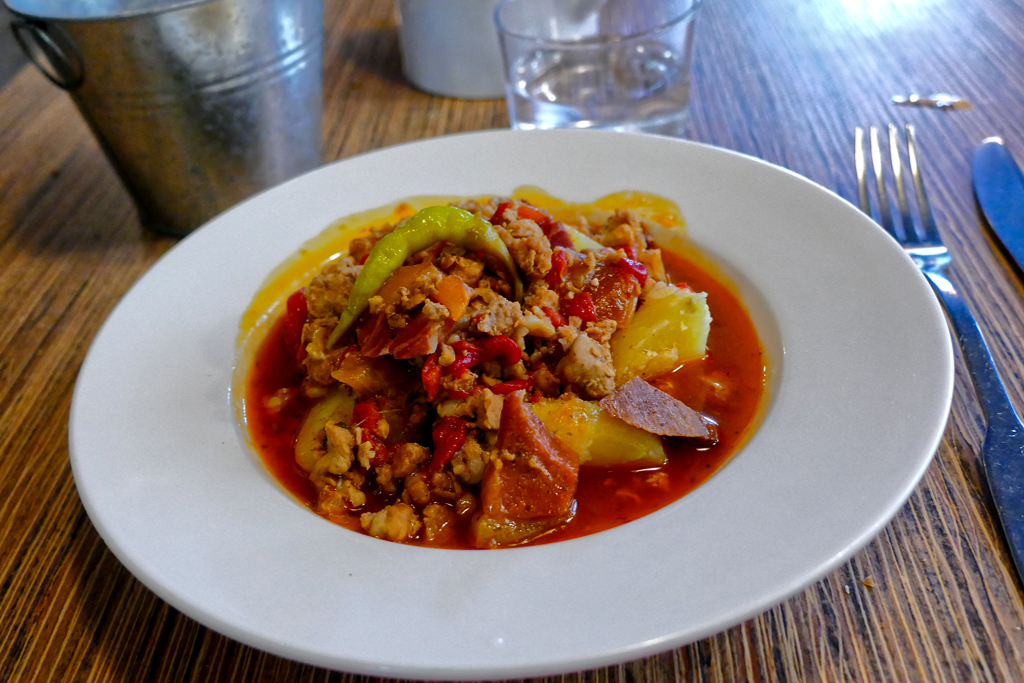
Needless to say, Bordeaux is famous for its red wines, with Merlot and Cabernet Sauvignon being the most widely planted grape varieties.
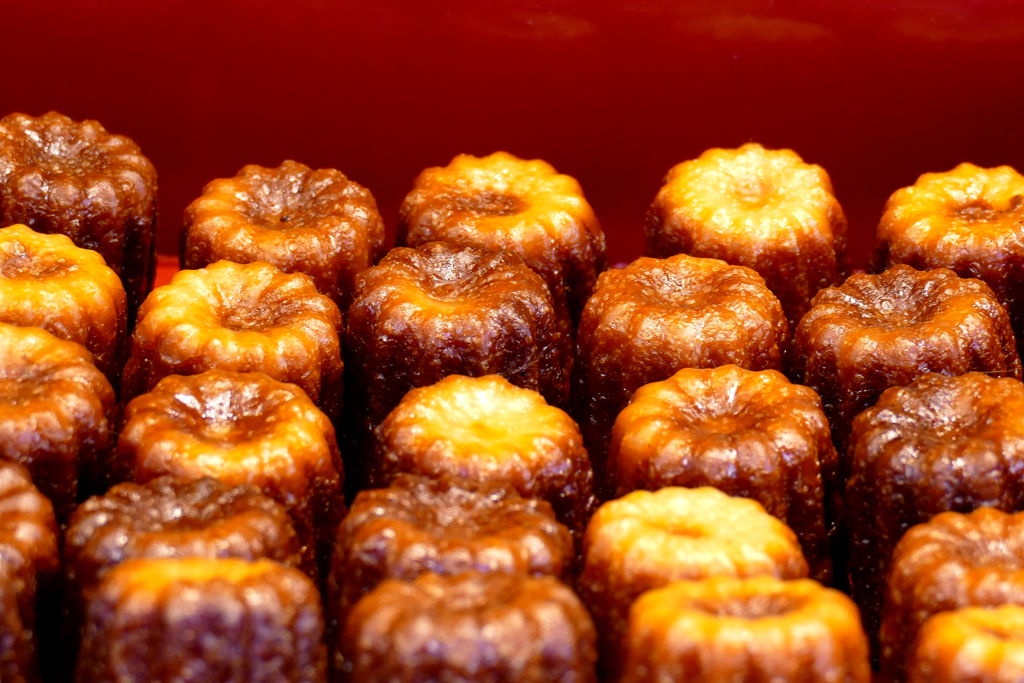
Finally, canelé can be found everywhere. These small, cylindrical pastries with a caramelized exterior and soft custard interior are not only a welcome sweet snack between meals. They also make an excellent, original souvenir from Bordeaux. Legend has it that they were invented as a way to use up leftovers: Winemakers used the egg white to gently clarify the wine. The leftover egg yolk was not discarded but used as an ingredient in delicious canelés.
Fun Fact
French cuisine is legendary worldwide. Far less known is the fact that France, after the USA and Canada, has the highest per capita consumption of McDonald’s products in the world.
Bon appétit!
Cash, Cards, And Deals
Since 2001, 20 European countries have paid with €uros, and France is one of them, obviously. The exchange rate is 1 US$ = 0,94 EUR as of June 2025, but you can check the conversion on this page. Also, you can pay with credit cards respectively your phone basically everywhere.
There is a lot to see in Bordeaux, and although it’s by far not the country’s most expensive city, entrance fees can quickly add up.
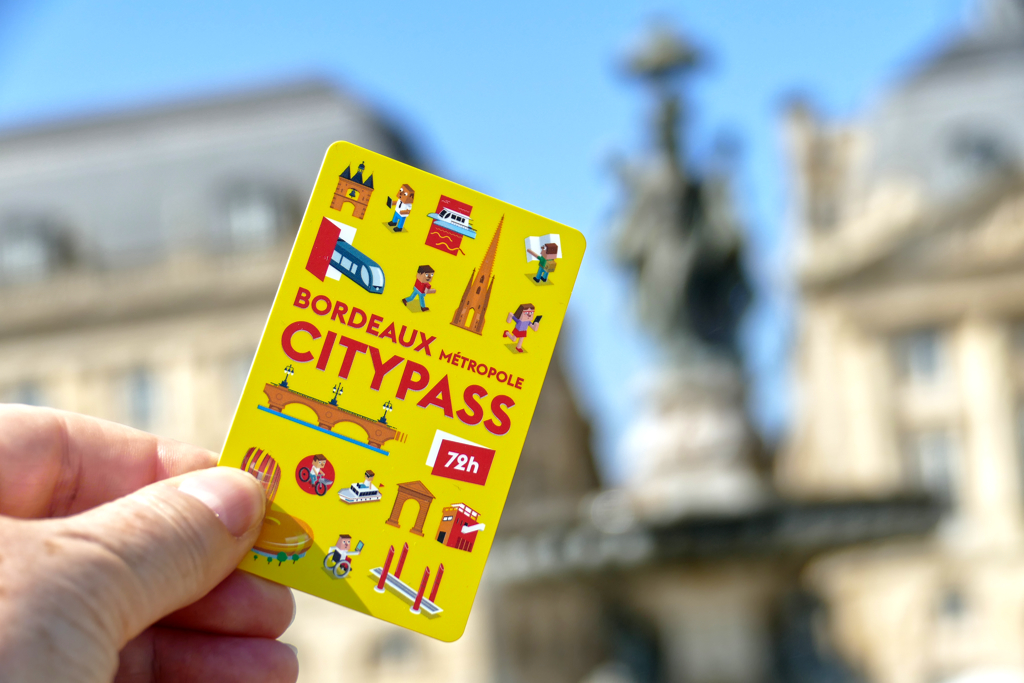
You can save quite a bit of money with the Bordeaux CityPass**, as it grants you free entry to the city’s main attractions and museums. It also includes free use of public transport, and you can choose from three different city tours: a walking tour, one by coach, and a commented cruise on the river Garonne, which I personally recommend.
The pass comes in three versions and can also be comfortably ordered online*:
| 24 hours | 48 hours | 72 hours |
| 37 €uros | 47 €uros | 55 €uros |
The use is not per day, but actually per hour, hence, the clock starts only ticking as soon as you activate your pass either on a public transport or at one of the attractions. So, if you play this little plastic card right, you can cleverly prolong its use.
Nevertheless, since you have to book some attractions such as climbing the Tour Pey Berland, the guided tour of the town hall, and any of the guided city tours, make sure to check immediately what there is to do and make your reservation as soon as possible to avoid disappointments.
Communication And Connection
Since June 2017, no roaming charges have been applied within the EU with a European mobile phone contract, This applies in all 27 countries of the European Union as well as in Iceland, Liechtenstein, and Norway, and to all contracts.
In case European roaming is unavailable, you can connect to the internet without any issue at basically every museum, eatery, café, and, of course, hotel.
If you insist on being online 24/7, you can get a SIM card, obviously. There are prepaid SIM cards from many companies. At 2.99 €uros, Orange France distributes the cheapest one. Other brands are SFR France, Bouygues Telecom, and Free Mobile. They cost 10 €uros. Keep in mind that some companies might also charge an activation fee.
In France, they use plug types C and E. Their voltage is 230 V, and the frequency is 50 Hz. Whereby nowadays, all these chargers have integrated adapters, so the voltage and frequency don’t really matter.
By the way, you’ll find comprehensive travel info in my recently thoroughly updated post World’s Most Complete Travel Information – an indispensable globetrotter classic.
Language
For the longest time, French people had a very bad reputation when it came to foreign languages. After my recent travels through France, I have to correct this image. At least in the tourism sector, the French have caught up quite a bit and speak at least a decent level of English. In the Southwest, due to their proximity to Spain, they often also speak at least rudimentary Spanish. So, it seems a new, somewhat more cosmopolitan generation is emerging.
This being said, it is, of course, appropriate, out of respect and courtesy, to at least learn some polite phrases with the help of Babbel or Lingohut, for example.
Extra-Tip
Also, don’t forget to say Bonjour as soon as you enter a shop, a restaurant, a bus…in short: everywhere! Make sure to start each and every conversation with Bonjour. Every single one without exception. No excusez-moi, nope, first a Bonjour, then the apology, then your question.
Map
On this map, you see where to find all those amazing spots and landmarks that make Bordeaux the proverbial Pearl of the Southwest. Clicking on the slider symbol at the top left or the full-screen icon at the top right will display the whole map, including the legend.
Pinnable Pictures
If you choose to pin this post for later, please use one of these pictures:
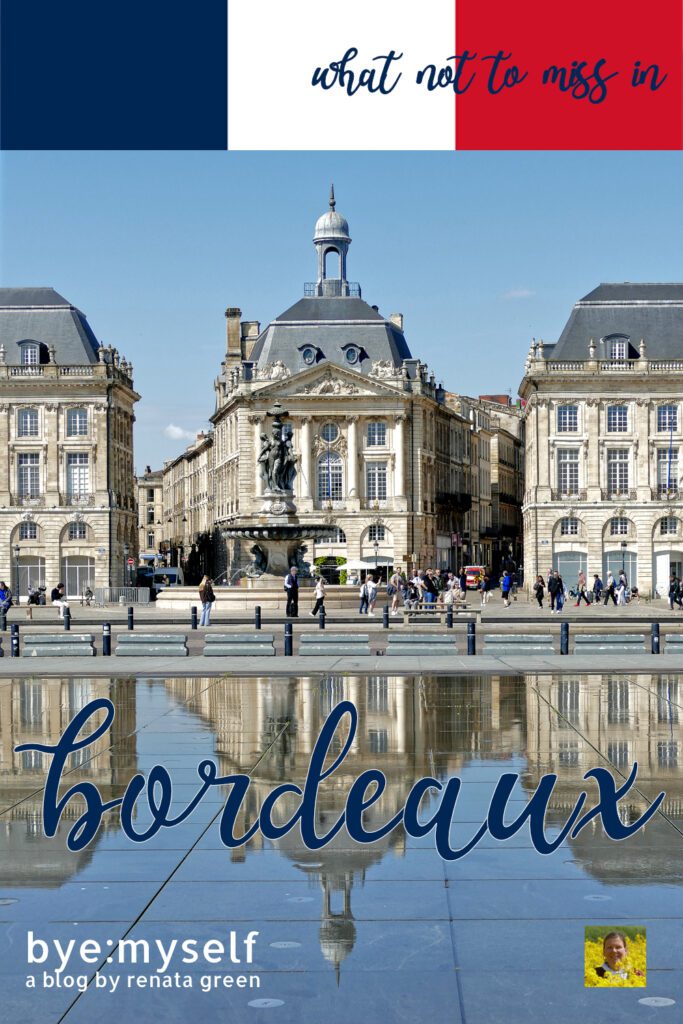
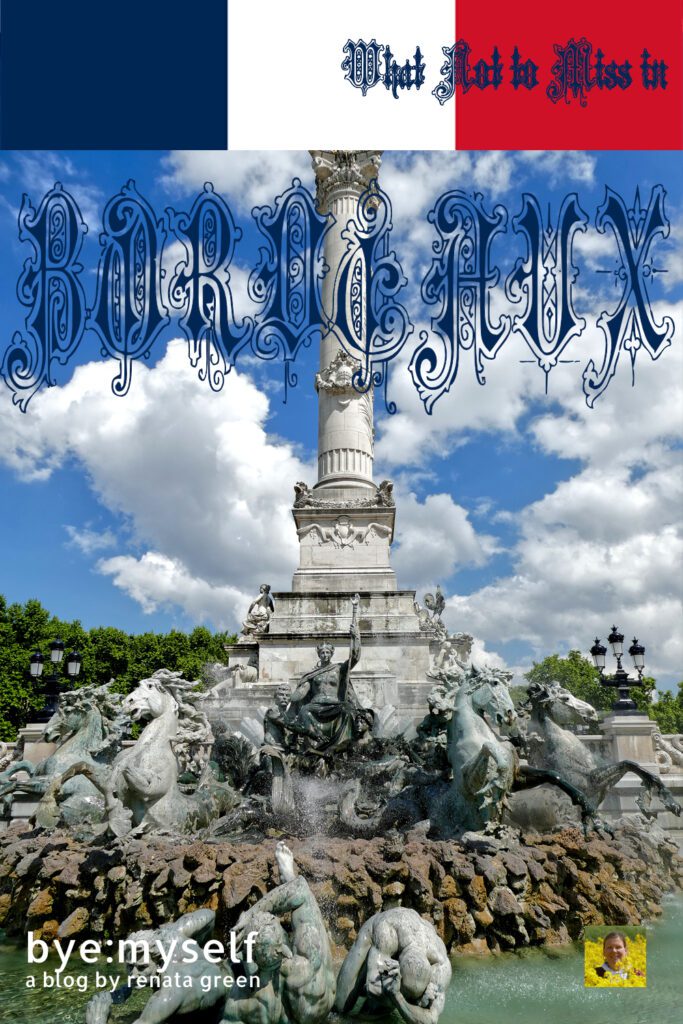
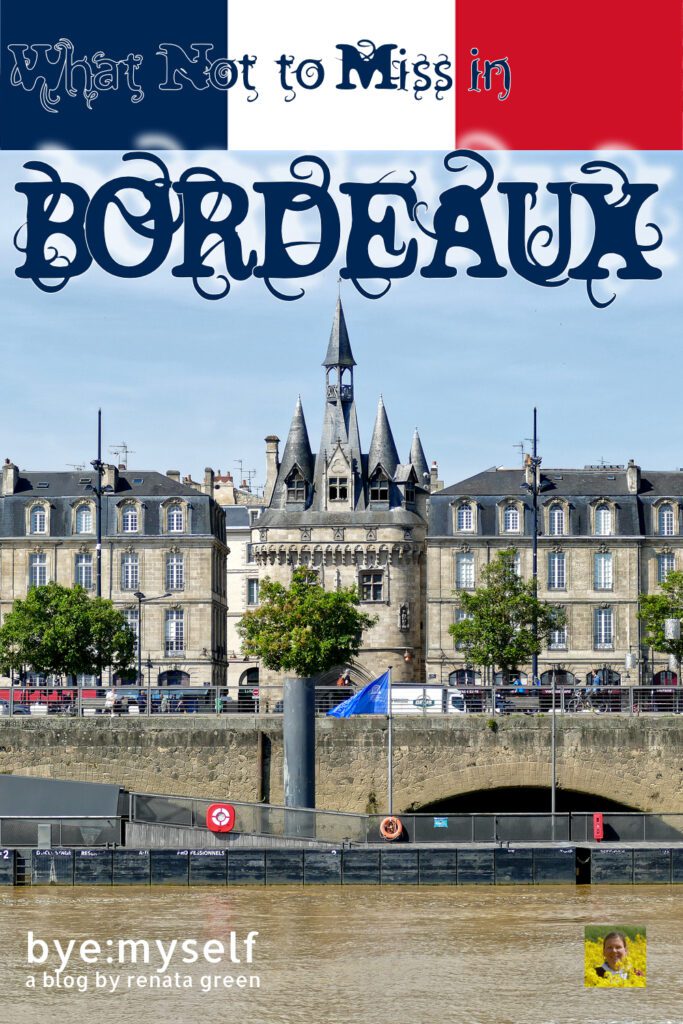
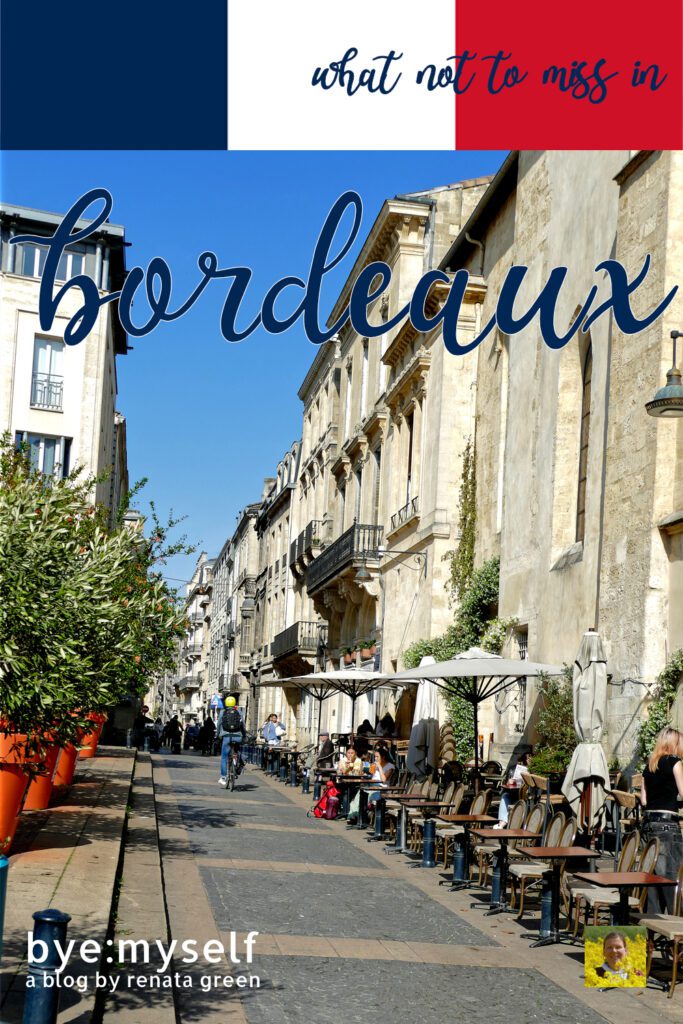
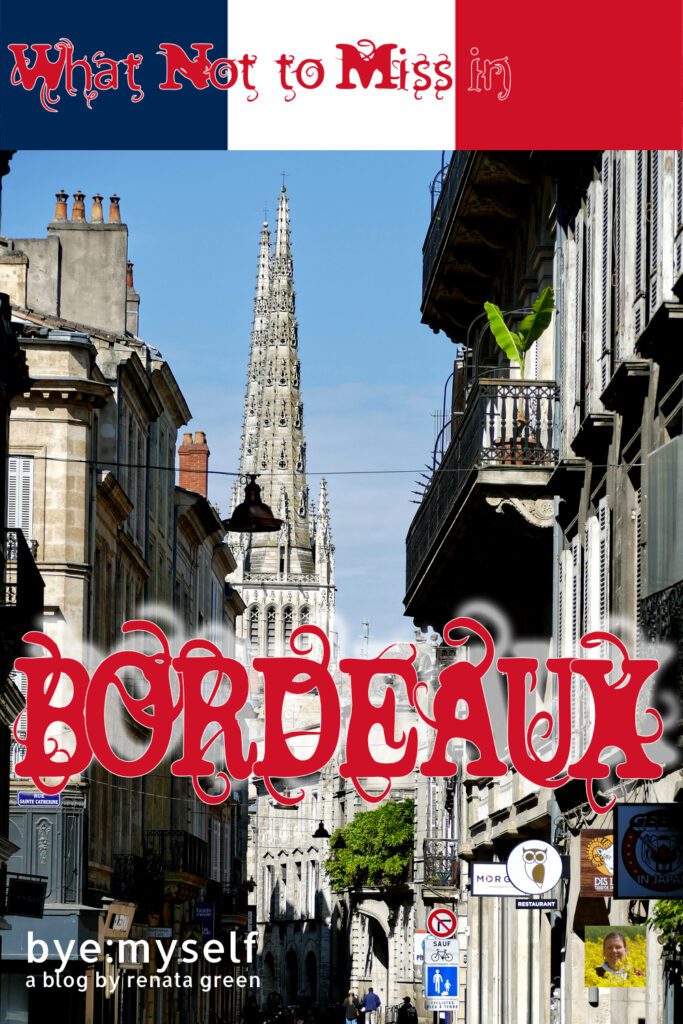

Did You Enjoy This Post? Then You Might Also Like These:
MAGNIFICENT MARTINIQUE: Ten Places Not to Miss on Your Visit (even when exploring by public bus)
24 hours in PARIS
Perfect Guide For a Day Trip to SAINT-EMILION
One Day in NÎMES – What Not to Miss in the Most Roman City of France
24 hours in BORDEAUX
Best Street Art in NÎMES
What Not to Miss in PARIS: 20 Must-Dos, Not Only for First-Timers
One Day in ARLES – What Not to Miss in Vincent’s Picture-Perfect City
Disclaimer: *This is an affiliate link. If you book through this page, not only do you get the best deal. I also get a small commission that helps me run this blog. Thank you so much for supporting me!
**The Office de Tourisme et des Congrès de Bordeaux supported my blogger trip by supplying me with a 72-hour CityPass. However, all opinions on these services are mine and weren’t by any means influenced by my cooperation partner.
